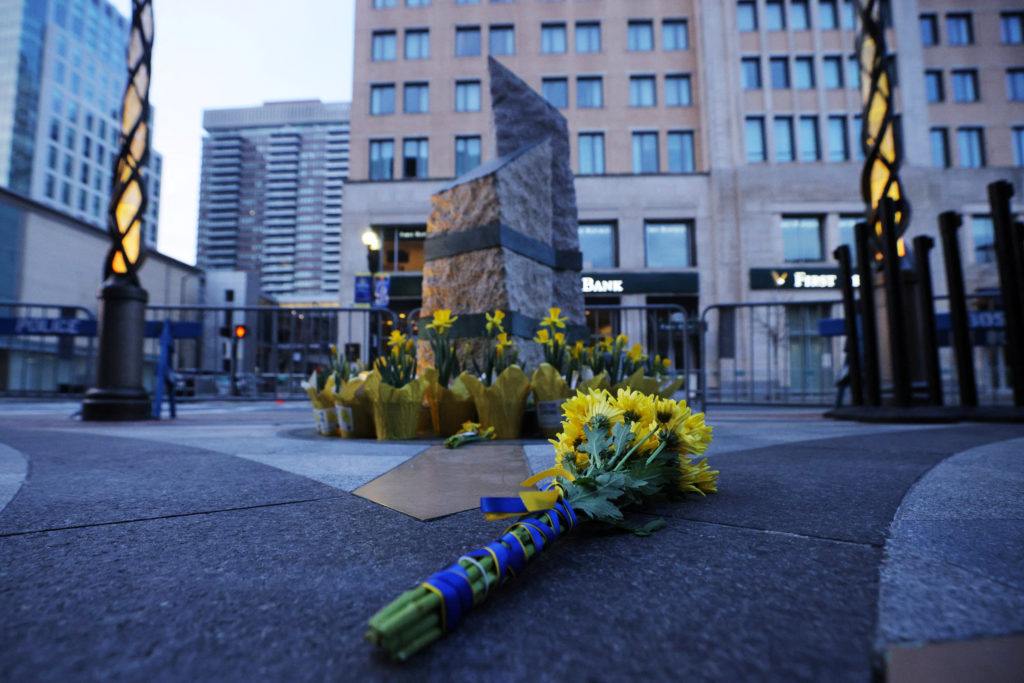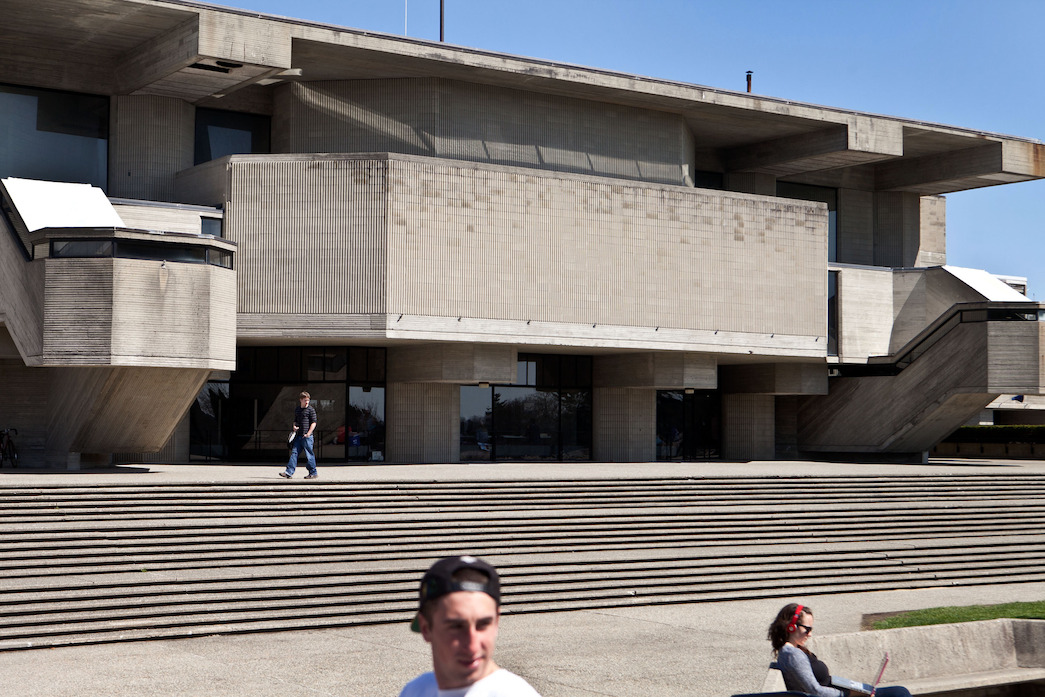Warning: Graphic content, readers’ discretion advised. This article contains a recollection of crime and can be triggering to some, readers’ discretion advised.
Three people were killed and more than 260 were injured when two pressure-cooker bombs went off at the marathon finish line. …..
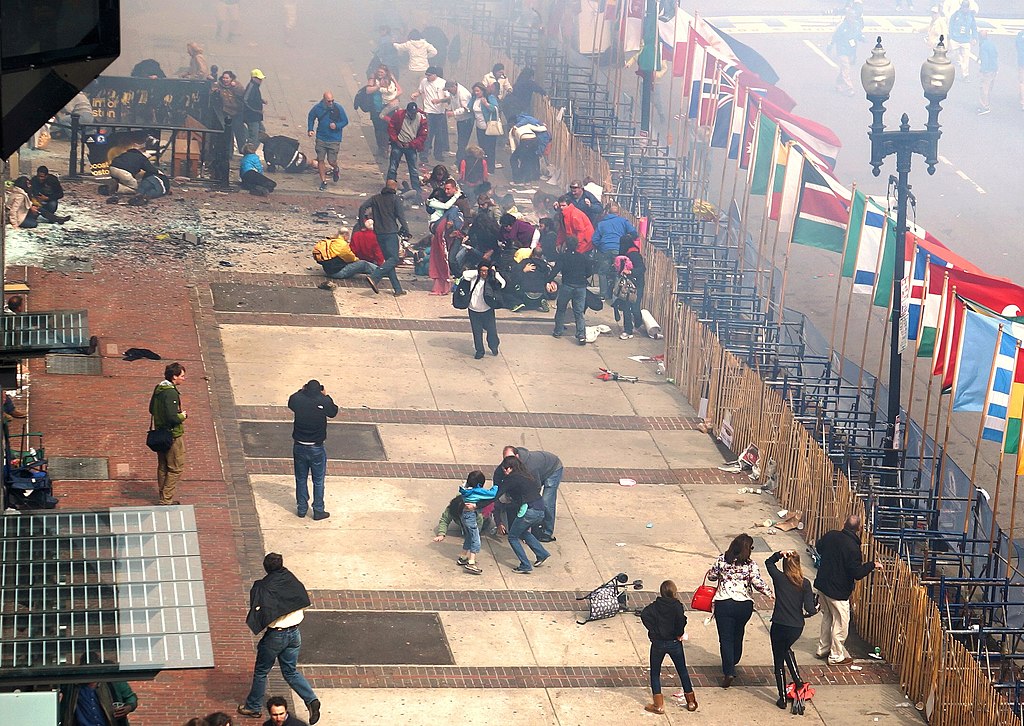
The Boston Marathon Bombing was a terrorist attack that occurred on April 15, 2013 when two bombs—planted by brothers Dzhokhar and Tamerlan Tsarnaev
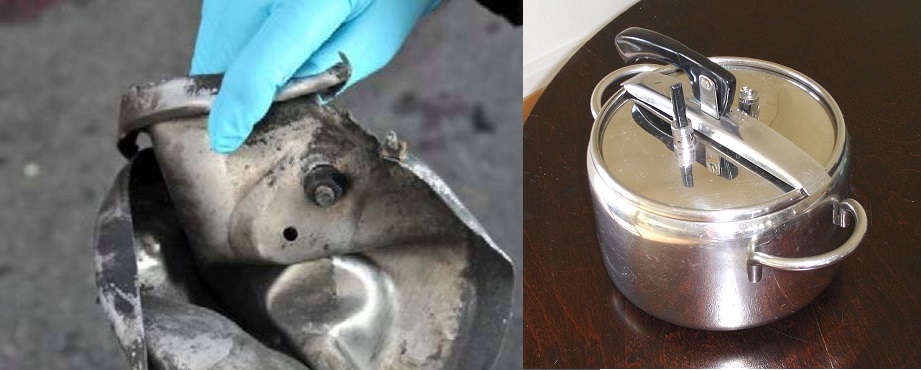
Pressure cooker fragment believed by the FBI to be part of one of the explosive devices used in the 2013 Boston Marathon bombings/ 2and picrue show´s pressure cooker.
A pressure cooker bomb is an improvised explosive device (IED) created by inserting explosive material into a pressure cooker and attaching a blasting cap into the cover of the cooker.
Pressure cooker bombs have been used in a number of attacks in the 21st century.
Among them have been the 2006 Mumbai train bombings, 2010 Stockholm bombings (failed to explode), the 2010 Times Square car bombing attempt (failed to explode), the 2013 Boston Marathon bombing, and the 2017 Manchester Arena bombing.Pressure cooker bombs are relatively easy to construct. Most of the materials required can be easily obtained. The bomb can be triggered using a simple electronic device such as a digital watch, garage door opener, cell phone, pager, kitchen timer, or alarm clock.The power of the explosion depends on the size of the pressure cooker and the amount and type of explosives used.
Similar to a pipe bomb, the containment provided by the pressure cooker means that the energy from the explosion is confined until the pressure cooker itself explodes. This in turn creates a relatively large explosion using low explosives and generating potentially lethal fragmentation.
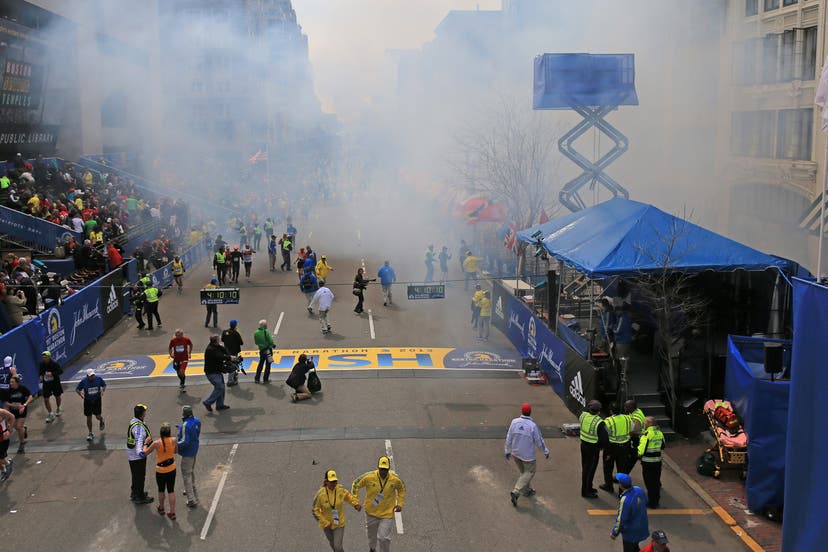
The Boston Marathon bombing was a domestic terrorist attack that took place during the annual Boston Marathon on April 15, 2013. Brothers Dzhokhar and Tamerlan Tsarnaev planted two homemade pressure cooker bombs, which detonated near the finish line of the race 14 seconds and 210 yards (190 m) apart. Three people were killed and hundreds injured, including 17 who lost limbs.
Three days later, the Federal Bureau of Investigation (FBI) released images of two suspects.They were later identified as the Tsarnaev brothers, who were Chechen Kyrgyzstani-Americans. Following their identification, they killed an MIT policeman, then kidnapped a man in his car. They had a shootout with the police in nearby Watertown, during which two officers were severely injured (one of whom, Dennis Simmonds, died a year later).
Tamerlan was shot several times, and his brother Dzhokhar ran him over while escaping in the stolen car. Tamerlan died soon after.
An unprecedented manhunt for Dzhokhar ensued, with thousands of law enforcement officers searching a 20-block area of Watertown. Residents of Watertown and surrounding communities were asked to stay indoors, and the transportation system and most businesses and public places closed.After a Watertown resident discovered Dzhokhar hiding in a boat in his backyard, the fugitive was shot and wounded by police before being taken into custody.
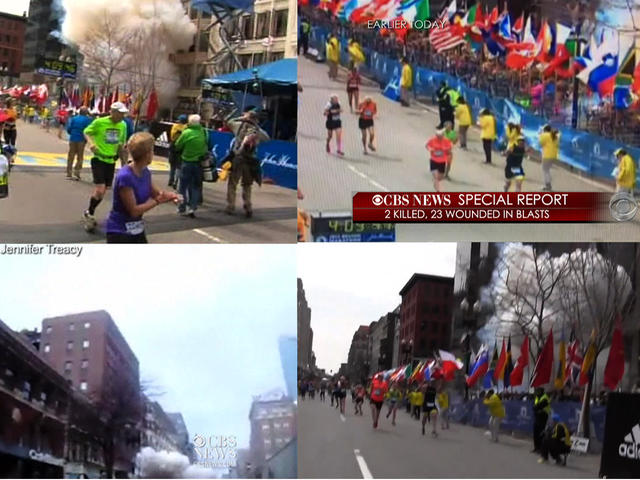
Different camera angles from the Boston Marathon explosion.
During questioning, Dzhokhar said that he and his brother were motivated by the wars in Iraq and Afghanistan, that they were self-radicalized and unconnected to any outside terrorist groups, and that he was following his brother’s lead. He said they learned to build explosive devices from the online magazine of Al-Qaeda in the Arabian Peninsula.He also said they had intended to travel to New York City to bomb Times Square.
He was convicted of 30 charges, including use of a weapon of mass destruction and malicious destruction of property resulting in death.
Two months later, he was sentenced to death,[18] but the sentence was vacated by the United States Court of Appeals for the First Circuit. A writ of certiorari was granted by the Supreme Court of the United States, which considered the questions of whether the lower court erred in vacating the death sentence. After hearing arguments as United States v. Tsarnaev, the Court upheld the death penalty, reversing the First Circuit Court’s decision.

An injured person is helped on the sidewalk near the Boston Marathon finish line following an explosion in Boston on Monday, April 15, 2013. (AP Photo/MetroWest Daily News,Ken McGagh)
The 117th annual Boston Marathon was run on Patriots’ Day, April 15, 2013. At 2:49 p.m. EDT (18:49 UTC), two bombs detonated about 210 yards (190 m) apart at the finish line on Boylston Street near Copley Square.The first exploded outside Marathon Sports at 671–673 Boylston Street at 2:49:43 p.m. At the time of the first explosion, the race clock at the finish line showed 04:09:43-the elapsed time since the Wave 3 startat at 10:40 a.m.
The second bomb exploded at 2:49:57 p.m.,14 seconds later and one block farther west at 755 Boylston Street.The explosions took place nearly three hours after the winning runner crossed the finish line,but with more than 5,700 runners yet to finish.
Windows on adjacent buildings were blown out, but there was no structural damage.Runners continued to cross the line until 2:57 p.m.
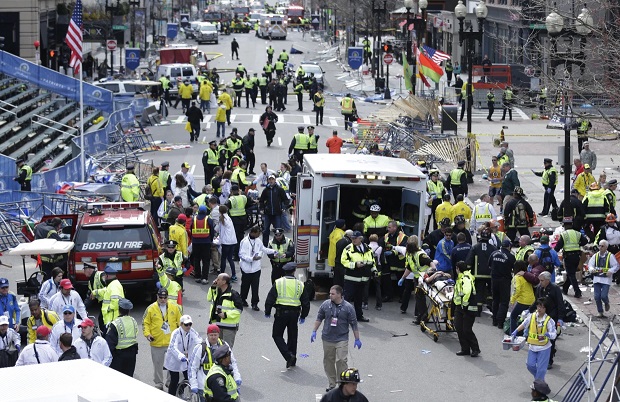
Rescue workers and medical personnel, on hand as usual for the marathon, gave aid as additional police, fire, and medical units were dispatched, including from surrounding cities as well as private ambulances from all over the state. The explosions killed 3 civilians and injured 281 others, who were treated at 27 local hospitals.
At least 14 people required amputations, with some suffering traumatic amputations as a direct result of the blasts.
Police, following emergency plans, diverted all remaining runners to Boston Common and Kenmore Square. The nearby Lenox Hotel and other buildings surrounding the scene were evacuated.Immediately after the bombing occurred and medically injured people were transported, the police closed a 15-block area around the blast site; this was reduced to a 12-block crime scene the next day.Boston police commissioner Edward F. Davis recommended that people stay off the streets.
Dropped bags and packages, abandoned as their owners fled from the blasts, increased uncertainty as to the possible presence of more bombs and many false reports were received.Simultaneously an electrical fire at the John F. Kennedy Presidential Library in nearby Dorchester was initially feared to be a bomb.
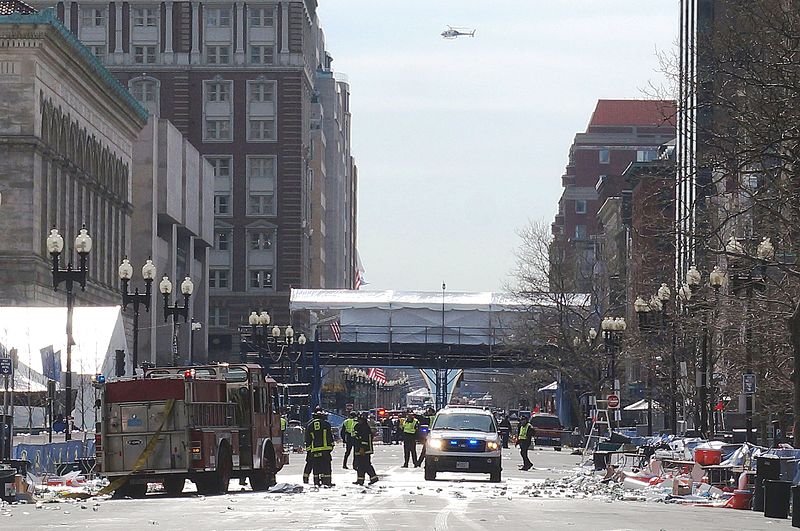
Emergency services at work after the bombing
The airspace over Boston was restricted, and departures halted from Boston’s Logan International Airport.Some local transit service was halted as well.
The Massachusetts Emergency Management Agency suggested people trying to contact those in the vicinity use text messaging instead of voice calls because of crowded cellphone lines.Cellphone service in Boston was congested but remained in operation, despite some local media reports stating that cell service was shut down to prevent cell phones from being used as detonators.
The American Red Cross helped concerned friends and family receive information about runners and casualties.The Boston Police Department also set up a call helpline for people concerned about relatives or acquaintances to contact and a line for people to provide information. Google Person Finder activated their disaster service under Boston Marathon Explosions to log known information about missing people as a publicly viewable file.
Due to the closure of several hotels near the blast zone, a number of visitors were left with nowhere to stay; many Boston-area residents opened their homes to them.
There were many local, state and federal, as well as charity/volunteer, agencies that responded to the attack and the manhunt/investigation.
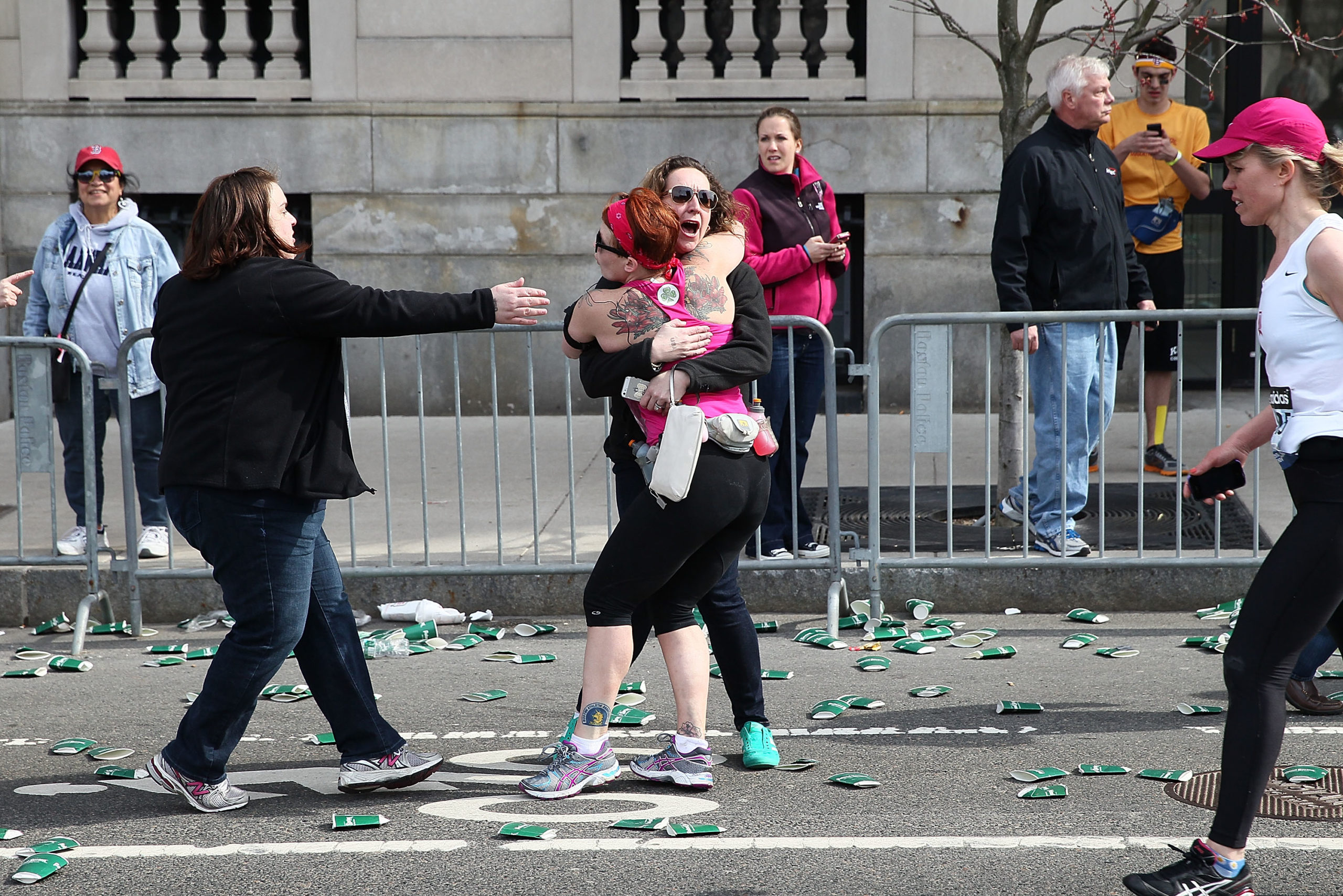
The Federal Bureau of Investigation led the investigation, assisted by the Bureau of Alcohol, Tobacco, Firearms and Explosives, the Central Intelligence Agency, the National Counterterrorism Center, and the Drug Enforcement Administration.
It was initially believed by some that North Korea was behind the attack after escalating tensions and threats with the U.S
United States government officials stated that there had been no intelligence reports suggesting such an attack.
Representative Peter King, a member of the House Intelligence Committee, said: “I received two top secret briefings last week on the current threat levels in the United States, and there was no evidence of this at all.”
After being identified, the father of the two suspects claimed that the FBI had been watching his family. He stated that they visited his sons’ home in Cambridge, Massachusetts five times, most recently in 2011, as “preventive work… afraid there might be some explosions on the streets of Boston”.
Evidence found near the blast sites included bits of metal, nails, ball bearings, black nylon pieces from a backpack,remains of an electronic circuit board, and wiring.A pressure cooker lid was found on a nearby rooftop.Both of the improvised explosive devices were pressure cooker
bombs manufactured by the bombers.Authorities confirmed that the brothers used bomb-making instructions found in Al Qaeda in the Arabian Peninsula’s Inspire magazine.After the suspects were identified, The Boston Globe reported that Tamerlan purchased fireworks from a fireworks store in New Hampshire.
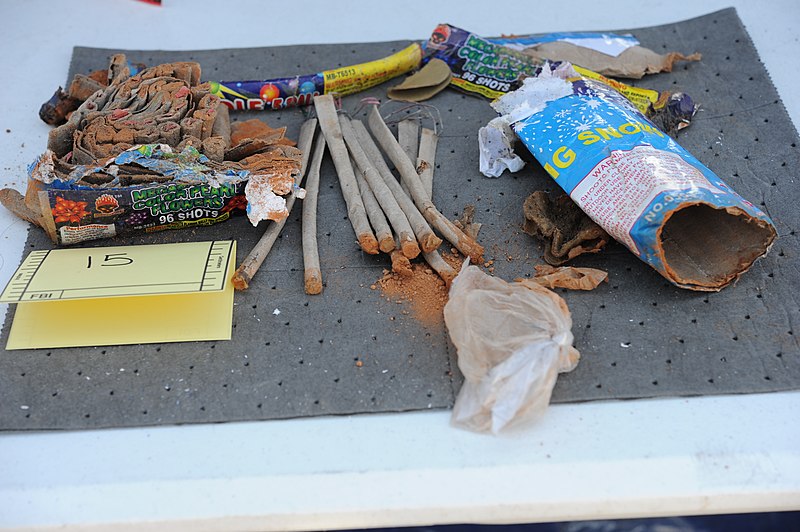
Emptied fireworks from Dzhokhar Tsarnaev’s backpack, found in a landfill near the UMass Dartmouth campus
On April 19, the FBI, West New York Police Department, and Hudson County Sheriff’s Department seized computer equipment from the apartment of the Tsarnaevs’ sister in West New York, New Jersey.
On April 24, investigators reported that they had reconstructed the bombs, and believed that they had been triggered by remote controls used for toy cars.
Jeff Bauman was immediately adjacent to one of the bombs and lost both legs; he wrote while in the hospital: “Bag, saw the guy, looked right at me”. He later gave a detailed description of the suspects, which enabled images of them to be identified and circulated quickly
At 5:20 p.m. on April 18, three days after the bombing, the FBI released images of two suspects carrying backpacks, asking the public’s help in identifying them.
The FBI said that they were doing this in part to limit harm to people wrongly identified by news reports and on social-media
.As seen on video, the suspects stayed to observe the chaos after the explosions, then walked away casually. The public sent authorities a
deluge of photographs and videos, which were scrutinized by both authorities and online public social networks
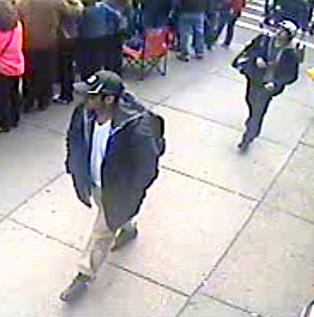
Security camera images of Tamerlan Tsarnaev (front) and Dzhokhar Tsarnaev just prior to the bombings
10:48 pm, hours after the photos were released, the Tsarnaev brothers ambushed and shot Sean A. Collier of the Massachusetts Institute of Technology Police Department six times in an attempt to steal his Smith & Wesson M&P45 sidearm, which they could not free from his holster because of its security retention system.
Collier, aged 27, was seated in his police car near Building 32 on the Massachusetts Institute of Technology campus.He died soon after.
The brothers then carjacked a Mercedes-Benz M-Class SUV in the Allston-Brighton neighborhood of Boston. Tamerlan took the owner, Chinese national Dun “Danny” Meng (Chinese: 孟盾), hostage and told him that he (Tamerlan) was responsible for the Boston bombing and for killing a police officer. Dzhokhar followed them in their green Honda Civic, later joining them in the Mercedes-Benz. Interrogation later revealed that the brothers “decided spontaneously” that they wanted to go to New York and bomb Times Square.
The Tsarnaev brothers forced Meng to use his ATM cards to obtain $800 in cash.They transferred objects to the Mercedes-Benz and one brother followed it in their Civic, for which an all-points bulletin was issued.
The Tsarnaev brothers then drove to a Shell gas station to fill up for a long ride to Times Square, New York City to set off more explosives. But while Dzhokhar went inside to pay for junk food, Meng, fearing that the suspects would harm him during the long drive, escaped from the Mercedes and ran across the street to the Mobil gas station, asking the clerk to call 911.His cell phone remained in the vehicle, allowing the police to focus their search on Watertown.
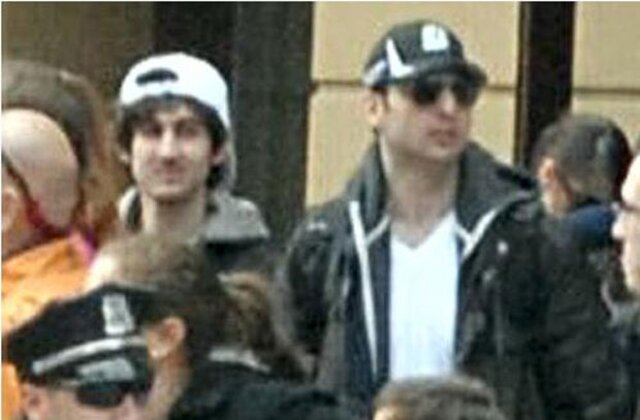
The Tsarnaev brothers at the mararthon.
Shortly after midnight on April 19, Watertown police officer Joseph Reynolds identified the brothers in the Honda and the stolen Mercedes after overhearing radio traffic that the vehicle was “pinged” by Cambridge officers on Dexter Avenue in Watertown. Reynolds followed the vehicle while waiting for additional units to perform a high-risk traffic stop when the suspect vehicles both turned onto Laurel Street and stopped at the intersection of Laurel and Dexter.
Tamerlan Tsarnaev stepped out of the Mercedes and immediately opened fire on Officer Reynolds and Sergeant John MacLellan, who both returned fire and requested emergency assistance over their radios.
A gun battle ensued between Tsarnaev, the aforementioned officers, and additional officers responding to the “shots fired” radio transmissions from Reynolds and MacLellan in the 100 block of Laurel St.
An estimated 200 to 300 shots were fired. The suspects shot 56 times, detonated at least one pressure cooker bomb, and threw five “crude grenades” three of which exploded.
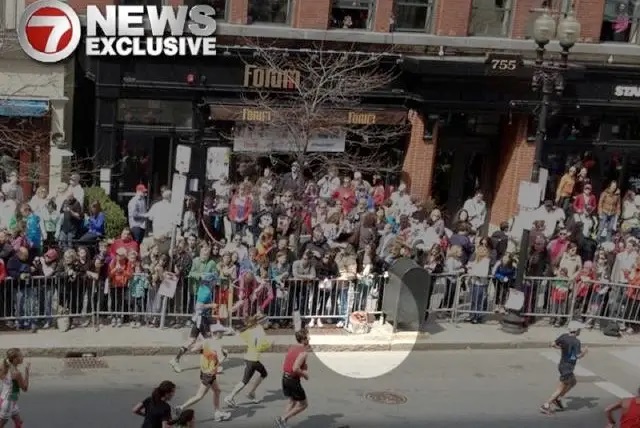
The agencies involved in the nearly seven-minute shootout included the Watertown Police Department, Cambridge Police Department, Boston Police Department, Massachusetts State Police (MSP), Boston University Police Department, and MBTA Transit Police Department. Most of the officers involved were equipped by their respective agencies with either the Glock 22 or Glock 23 .40 S&W-caliber pistols. MSP troopers were armed with Smith & Wesson M&P45 pistols chambered in .45 ACP; this led investigators to match the 9mm casings and projectiles found at the scene to the suspects’ 9mm Ruger P95 pistol.
According to Watertown Police Chief Edward Deveau, the brothers had an “arsenal of guns”. Tamerlan eventually ran out of ammunition and threw his empty Ruger pistol at Watertown PD Sergeant Jeffrey Pugliese, who subsequently tackled him with assistance from Sergeant MacLellan.
Tamerlan’s younger brother Dzhokhar then drove the stolen SUV toward Tamerlan and the police, who unsuccessfully tried to drag Tamerlan out of the car’s path and handcuff him;the car ran over Tamerlan and dragged him a short distance down the street, narrowly missing the Watertown officers. Watertown Sgt. MacLellan later stated that the younger brother had thought they were doing CPR on another officer and tried to run them over Dzhokhar abandoned the car half a mile away and fled on foot.Badly wounded, Tamerlan Tsarnaev was taken into custody and died at 1:35 a.m. at Beth Israel Deaconess Medical Center.
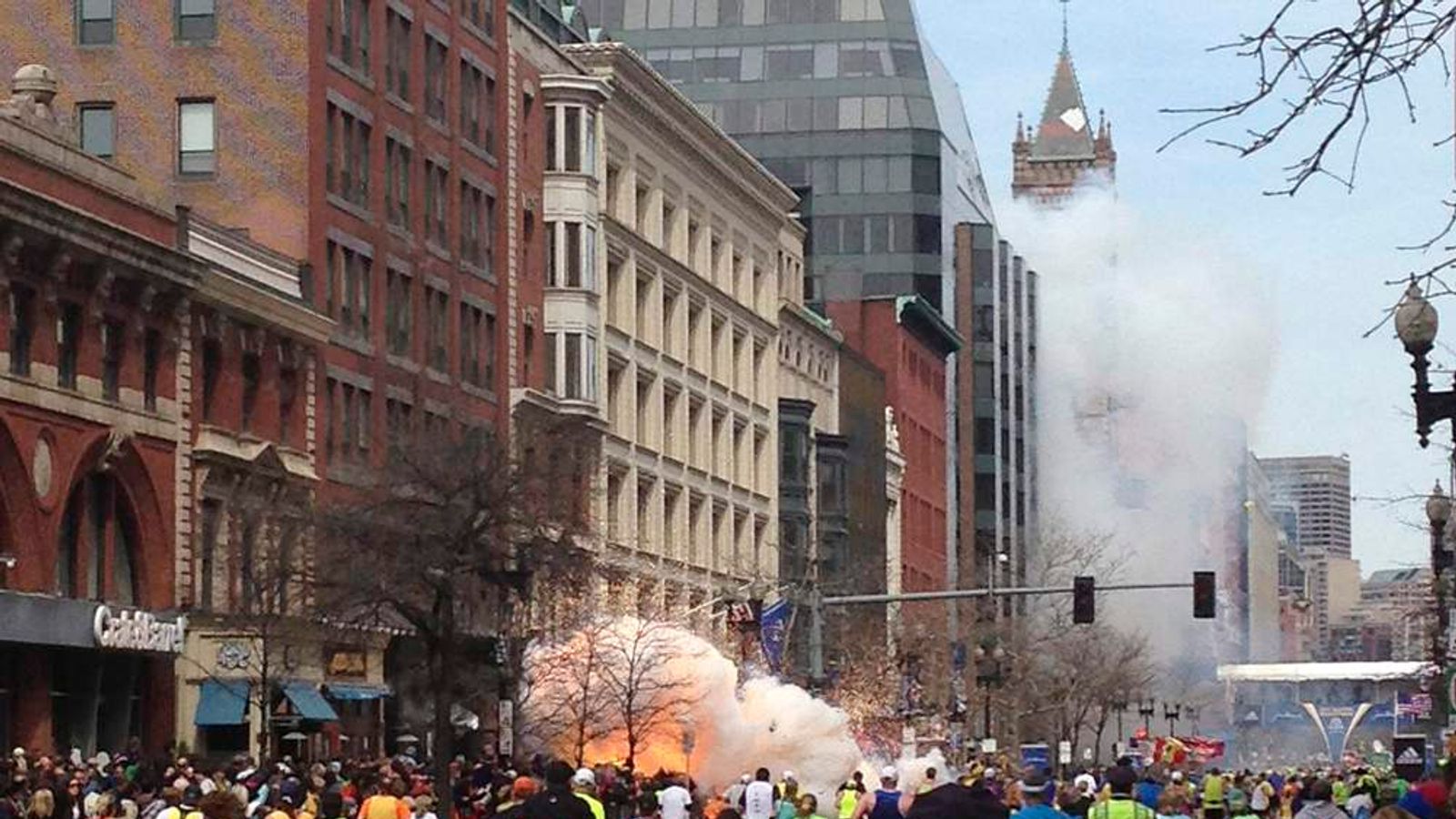
Massachusetts Bay Transportation Authority Police Officer Richard H. Donohue Jr. was critically wounded in the leg in crossfire from other officers shooting at the fleeing vehicle, but survived. Reports revealed that his gunshot wound severed his femoral artery, and he nearly died from bleeding out, but fast-acting efforts by his fellow officers and medical personnel saved his life.
Boston Police Department officer Dennis Simmonds was injured by a hand grenade and died on April 10, 2014. 15 other officers were also injured. A later report by Harvard Kennedy School’s Program on Crisis Leadership concluded that lack of coordination among police agencies had put the public at excessive risk during the shootout.
Only one firearm was recovered at the scene, Tsarnaev’s Ruger P95, which was found to have a defaced serial number.
Records on the Honda left at the scene identified the men as two brothers whose family had migrated to the United States from Kyrgyzstan seeking political asylum around 2002: 26-year-old Tamerlan Tsarnaev and 19-year-old Dzhokhar “Jahar” Tsarnaev.
The FBI released additional photos of the two during the Watertown incident.
Early on April 19, Watertown residents received automated calls asking them to stay indoors.That same morning Governor Patrick asked residents of Watertown and adjacent cities and townsto “shelter in place”.Somerville residents also received automated calls instructing them to shelter in place.
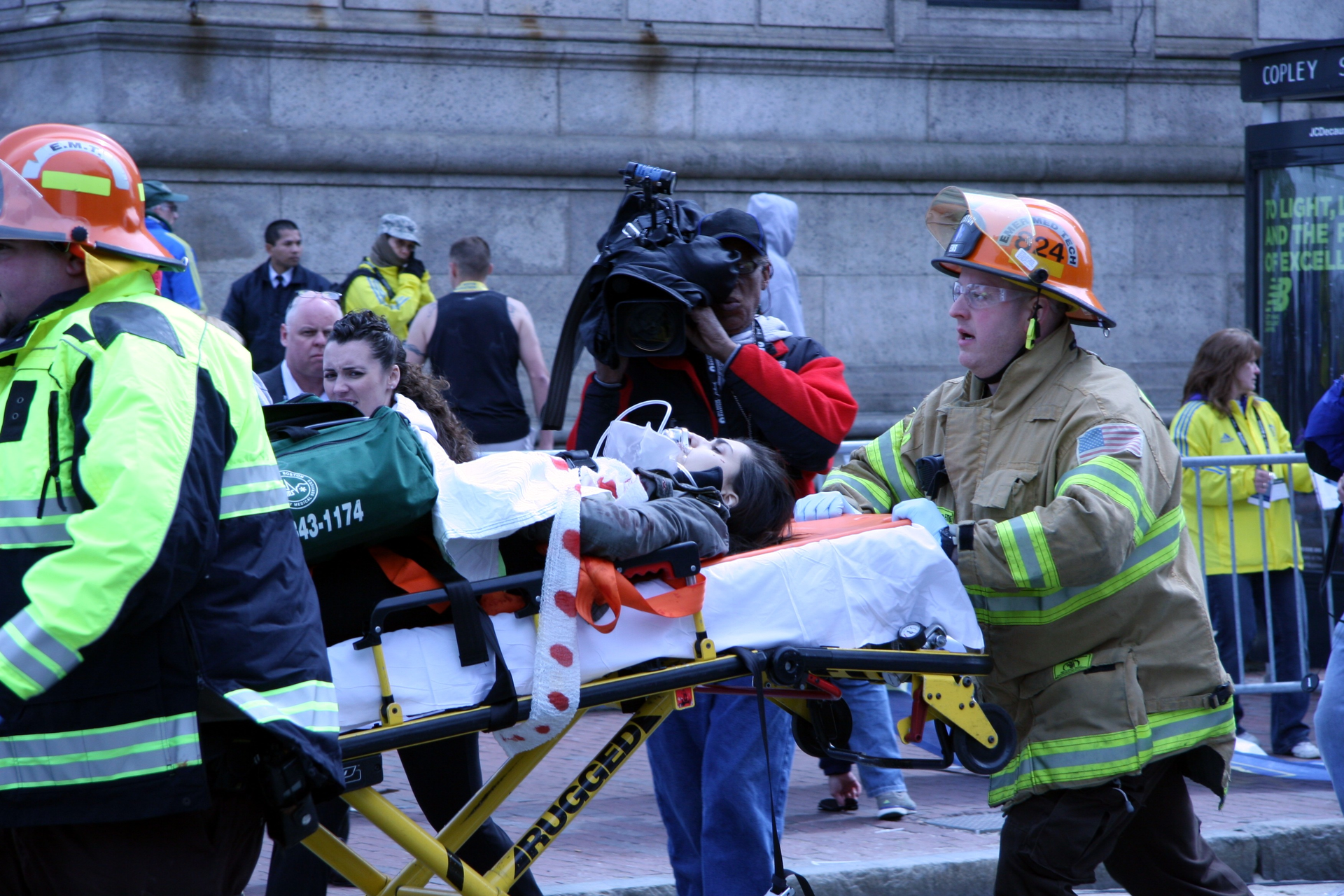
A 20-block area of Watertown was cordoned off and residents were told not to leave their homes or answer the door, as officers scoured the area in tactical gear. Helicopters circled the area and SWAT teams in armored vehicles moved through in formation, with officers going door to door and searching houses.These actions generated discussions about the legality of searching large numbers of houses without a search warrant, with The Atlantic stating that this kind of search is legal due to exigent circumstances.
On the scene were the FBI, the Bureau of Alcohol, Tobacco, Firearms and Explosives, Diplomatic Security Service,
HSI-ICE, the National Guard, the Boston, Cambridge, Watertown Police departments, and the Massachusetts State Police. The show of force was the first major field test of the interagency task forces created in the wake of the September 11 attacks.
The entire public transit network and most Boston taxi services were suspended, as was Amtrak service to and from Boston.Logan International Airport remained open under heightened security.Universities, schools, many businesses, and other facilities were closed as thousands of law enforcement personnel participated in the door-to-door manhunt in Watertown. Others followed up on other leads, including searching the house that the brothers shared in Cambridge, where seven improvised explosive devices were found.
The brothers’ father spoke from his home in Makhachkala, Dagestan, encouraging Dzhokhar to: “Give up. You have a bright future ahead of you. Come home to Russia.” He continued, “If they killed him, then all hell would break loose.” On television, Dzhokhar’s uncle from Montgomery Village, Maryland, pleaded with him to turn himself in.
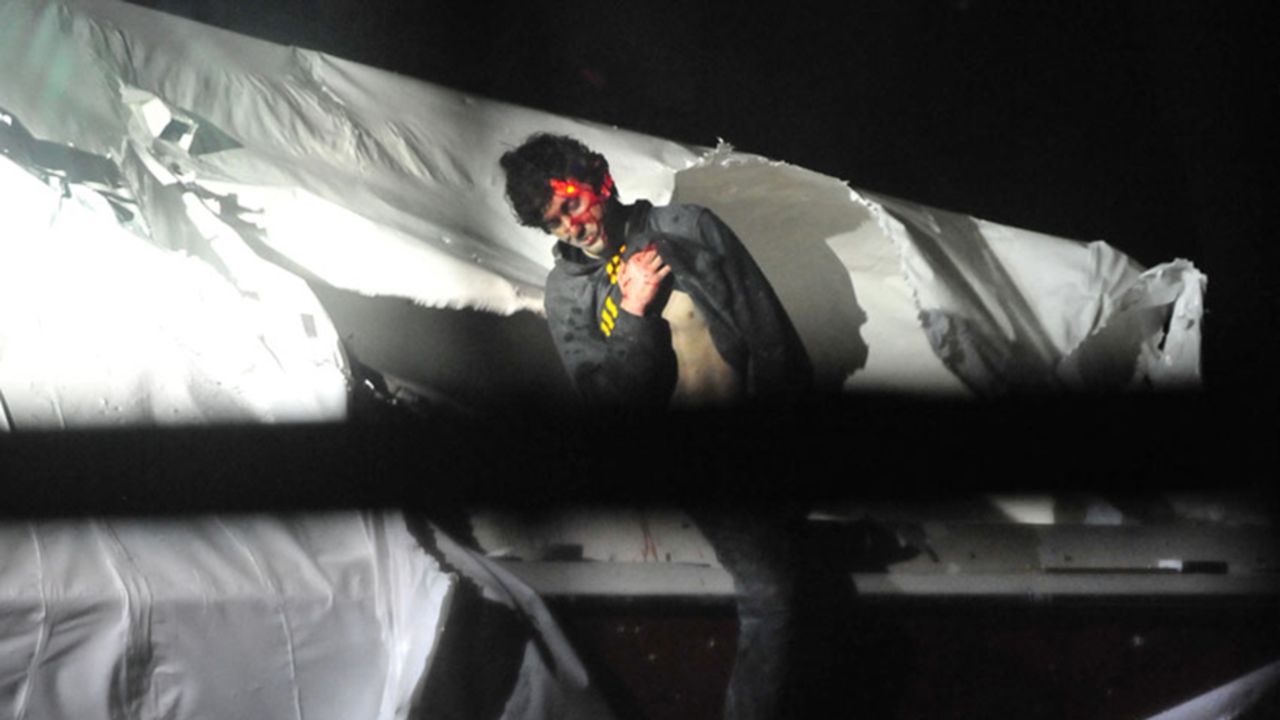
July 18, 2013, show Tsarnaev as he emerges from the boat where he hid in Watertown, Massachusetts.
On the evening of April 19, two hours after the shelter-in-place order had been lifted, David Henneberry, a Watertown resident outside the search area, noticed that the tarp was loose on his parked boat.
Investigating, he saw a body lying inside the boat in a pool of blood.He contacted the authorities, who surrounded the boat. A police helicopter verified movement through a thermal imaging device.he figure inside started poking at the tarp, prompting police to shoot at the boat.
According to Boston Police Commissioner Ed Davis and Watertown Police Chief Deveau, Dzhokhar Tsarnaev was shooting at police from inside the boat, “exchanging fire for an hour”. A subsequent report indicated that the firing lasted for a shorter time.Despite this, Tsarnaev was found to have no weapon when he was captured.
Dzhokhar Tsarnaev was arrested at 8:42 p.m. and taken to Beth Israel Deaconess Medical Center, where he was listed in critical condition with gunshot wounds to the head, neck, legs, and hand. Initial reports that the neck wound represented a suicide attempt were contradicted by him being unarmed. The situation was chaotic, according to a police source quoted by The Washington Post, and the firing of weapons occurred during “the fog of war”.
A subsequent review by the Commonwealth of Massachusetts provided this more specific summary: “One officer fired his weapon without appropriate authority in response to perceived movement in the boat, and surrounding officers followed suit in a round of ‘contagious fire’, assuming they were being fired on by Tsarnaev.
Weapons continued to be fired for several seconds until on scene supervisors ordered a ceasefire and regained control of the scene. The unauthorized shots created another dangerous crossfire situation”.
These confusions were caused in part by a lack of clearly identified and coordinated law enforcement command of the thousands of officers from surrounding communities who self-deployed into the Watertown area during the events.
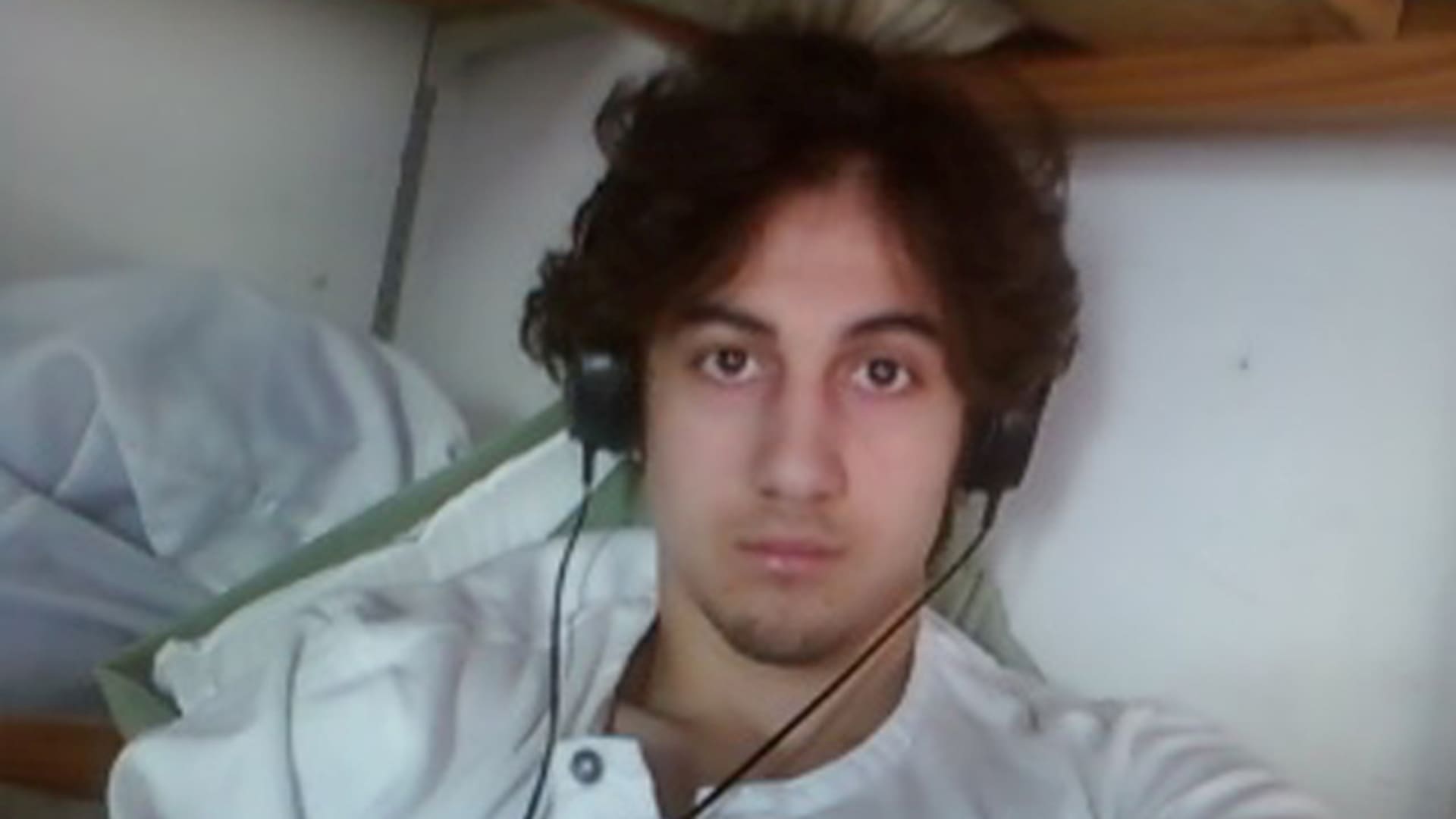
Dzhokhar Tsarnaev
Dzhokhar was questioned for 16 hours by investigators but stopped communicating with them on the night of April 22 after Judge Marianne Bowler read him a Miranda warning.Dzhokhar had not previously been given a Miranda warning, as federal law enforcement officials invoked the warning’s public safety exception. This raised doubts whether his statements during this investigation would be admissible as evidence and led to a debate surrounding Miranda rights.
On April 22, 2013, formal criminal charges were brought against Tsarnaev in the United States District Court for the District of Massachusetts during a bedside hearing while he was hospitalized. He was charged with use of a weapon of mass destruction and with malicious destruction of property resulting in death. Some of the charges carry potential sentences of life imprisonment or the death penalty.
Tsarnaev was judged to be awake, mentally competent, and lucid, and he responded to most questions by nodding. The judge asked him whether he was able to afford an attorney and he said no; he was represented by the Federal Public Defender’s office.
On April 26, Dzhohkar Tsarnaev was moved from Beth Israel Deaconess Medical Center to the Federal Medical Center at Fort Devens, about 40 miles (64 km) from Boston. FMC Devens is a federal prison medical facility at a former Army base where he was held in solitary confinement at a segregated housing unit with 23-hour-per-day lockdown.
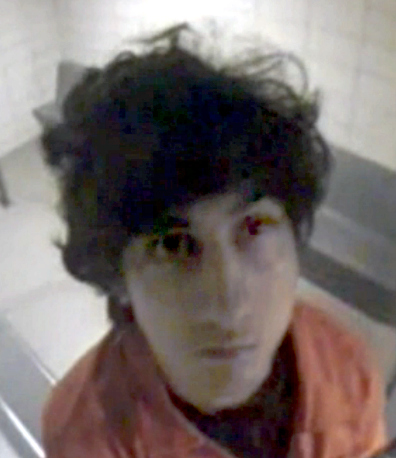
Dzhokhar Tsarnaev in a court holding cell on July 10, 2013
On July 10, 2013, Tsarnaev pleaded not guilty to 30 charges in his first public court appearance, including a murder charge for MIT police officer Sean Collier.He was back in court for a status hearing on September 23,and his lawyers requested more time to prepare their defense.
On October 2, Tsarnaev’s attorneys asked the court to lift the special administrative measures (SAMs) imposed by Attorney General Holder in August, saying that the measures had left Tsarnaev unduly isolated from communication with his family and lawyers, and that no evidence suggested that he posed a future threat.
Jury selection began on January 5, 2015, and was completed on March 3, with a jury consisting of eight men and ten women (including six alternates). The trial began on March 4 with Assistant U.S. Attorney William Weinreb describing the bombing and painting Dzhokhar as “a soldier in a holy war against Americans” whose motive was “reaching paradise”. He called the brothers equal participants.
Defense attorney Judy Clarke admitted that Dzhokhar Tsarnaev had placed the second bomb and was present at the murder of Sean Collier, the carjacking of Dun Meng, and the Watertown shootout, but she emphasized the influence that his older brother had on him, portraying him as a follower.Between March 4 and 30, prosecutors called more than 90 witnesses, including bombing survivors who described losing limbs in the attack, and the government rested its case on March 30. The defense rested as well on March 31, after calling four witnesses.
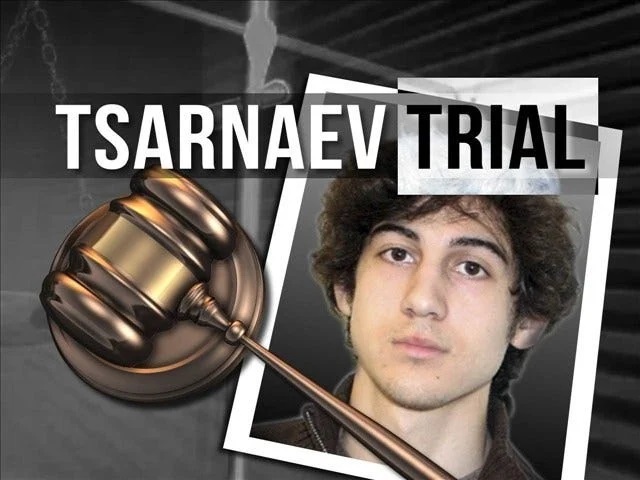
Tsarnaev was found guilty on all 30 counts on April 8. The sentencing phase of the trial began on April 21, and a further verdict was reached on May 15 in which it was recommended that he be put to death. Tsarnaev was sentenced to death on June 24, after apologizing to the victims. In 2018 Tsarnaev’s lawyers appealed on the grounds that a lower-court judge’s refusal to move the case to another city not traumatized by the bombings deprived him of a fair trial.
On July 30, 2020, Tsarnaev’s death sentence was reversed by the United States Court of Appeals for the First Circuit, which found that, during jury selection, the District Court did not properly screen prospective jurors on how much they had heard of the case. The First Circuit vacated the death sentence and three of the other thirty convictions against Tsarnaev, and ordered a new penalty phase jury trial with fresh jurors, leaving the decision of a new change of venue to the District Court. Tsarnaev’s remaining convictions still carried multiple life sentences, ensuring that he would remain in prison regardless of the results of the new trial.
The United States government appealed this ruling to the U.S. Supreme Court, which granted certiorari in the case United States v. Tsarnaev in March 2021, which was argued before the Court on October 13, 2021. On March 4, 2022, the Supreme Court reversed the decision of the First Circuit and reinstated Tsarnaev’s death penalty.
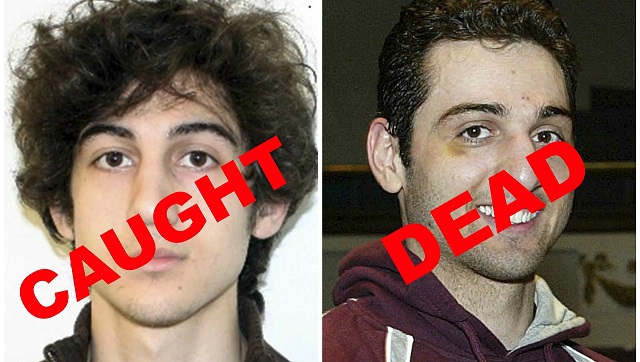
According to FBI interrogators, Dzhokhar and his brother were motivated by extremist beliefs but “were not connected to any known terrorist groups”, instead learning to build explosive weapons from an online magazine published by al-Qaeda affiliates in Yemen. They further alleged that “Dzhokhar and his brother considered suicide attacks and striking the Boston Pops Fireworks Spectacular on the Fourth of July”; but ultimately decided to use remotely-activated pressure cooker bombs and other IEDs.
Fox News reported that the brothers “chose the prestigious race as a ‘target of opportunity’ … after the building of the bombs came together more quickly than expected”.
Dzhokhar said that he and his brother wanted to defend Islam from the U.S., accusing the U.S. of conducting the Iraq War and War in Afghanistan against Muslims.
A CBS report revealed that Dzhokhar had scrawled a note with a marker on the interior wall of the boat where he was hiding; the note stated that the bombings were “retribution for U.S. military action in Afghanistan and Iraq”, and called the Boston victims “collateral damage”, “in the same way innocent victims have been collateral damage in U.S. wars around the world”. Photographs of the note were later used in the trial.
Some political science and public policy writers suggest that Islam may have played a secondary role in the attacks.These writers theorize that the primary motives might have been sympathy towards the political aspirations in the Caucasus region and Tamerlan’s inability to become fully integrated into American society.
According to the Los Angeles Times, a law enforcement official said that Dzhokhar “did not seem as bothered about America’s role in the Muslim world” as his brother Tamerlan had been.
Dzhokhar identified Tamerlan as the “driving force” behind the bombing, and said that his brother had only recently recruited him to help.
Some journalists and Dzhokhar Tsarnaev’s defense attorney have suggested that the FBI may have recruited or attempted to recruit Tamerlan Tsarnaev as an informant.
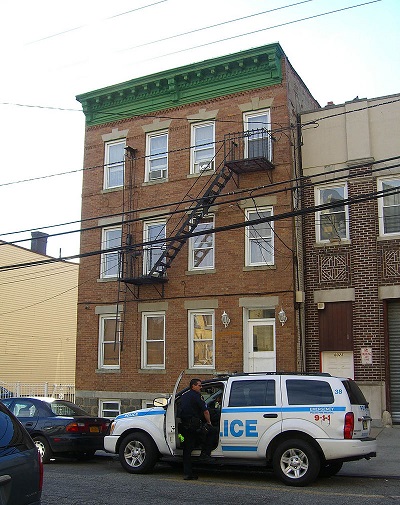
An apartment was searched in West New York, New Jersey, that belonged to a sister of the Tsarnaevs.
Tamerlan Tsarnaev was born in 1986 in the Kalmyk Autonomous Soviet Socialist Republic, North Caucasus. Dzhokhar was born in 1993 in Kyrgyzstan, although some reports say that his family claims that he was born in Dagestan.The family spent time in Tokmok, Kyrgyzstan, and in Makhachkala, Dagestan.They are half Chechen through their father Anzor, and half Avar through their mother Zubeidat. They never lived in Chechnya, yet the brothers identified themselves as Chechen.
The Tsarnaev family immigrated to the United States in 2002 where they applied for political asylum, settling in Cambridge, Massachusetts.
Tamerlan Tsarnaev attended Bunker Hill Community College but dropped out to become a boxer. His goal was to gain a place on the U.S. Olympic boxing team, saying that, “unless his native Chechnya becomes independent”, he would “rather compete for the United States than for Russia”.
He married U.S. citizen Katherine Russell on July 15, 2010, in the Masjid Al Quran Mosque. While initially quoted in a student magazine as saying, “I don’t have a single American friend. I don’t understand them,” a later FBI interview report documents Tamerlan stating it was a misquote, and that most of his friends were American.He had a history of violence, including an arrest in July 2009 for assaulting his girlfriend.
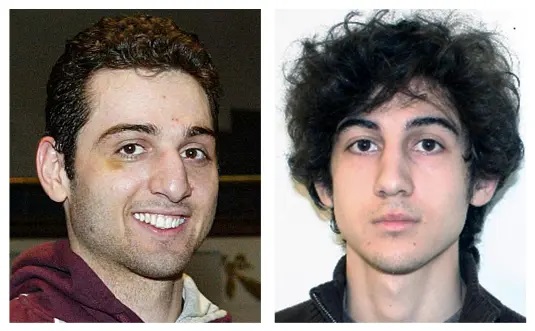
The brothers were Muslim; Tamerlan’s aunt stated that he had recently become a devout Muslim.Tamerlan became more devout and religious after 2009,and a YouTube channel in his name was linked to Salafist[and Islamist videos. The FBI was informed by the Russian Federal Security Service (FSB) in 2011 that he was a “follower of radical Islam”.
In response, the FBI interviewed Tamerlan and his family and searched databases, but they did not find any evidence of “terrorism activity, domestic or foreign”.During the 2012 trip to Dagestan, Tamerlan was reportedly a frequent visitor at a mosque on Kotrova Street in Makhachkala,believed by the FSB to be linked with radical Islam.
Some believe that “they were motivated by their faith, apparently an anti-American, radical version of Islam” acquired in the U.S.,while others believe that the turn happened in Dagestan.
At the time of the bombing, Dzhokhar Tsarnaev was a student at the University of Massachusetts Dartmouth with a major in marine biology. He became a naturalized U.S. citizen on September 11, 2012. Tamerlan’s boxing coach reported to NBC that the young brother was greatly affected by Tamerlan and admired him
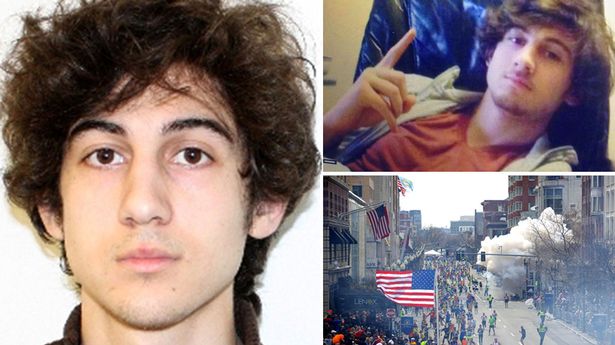
Tamerlan was previously connected to the triple homicide in Waltham, Massachusetts, on the evening of September 11, 2011, but he was not a suspect at the time.Brendan Mess, Erik Weissman, and Raphael Teken were murdered in Mess’s apartment. All had their throats slit from ear to ear with such great force that they were nearly decapitated.
The local district attorney said that it appeared that the killer and the victims knew each other, and that the murders were not random.Tamerlan Tsarnaev had previously described murder victim Brendan Mess as his “best friend”.After the bombing and subsequent revelations of Tsarnaev’s personal life, the Waltham murders case was reexamined in April 2013 with Tsarnaev as a new suspect.Both ABC and The New York Times have reported that there is strong evidence which implicates Tsarnaev in this triple homicide.
Some analysts claim that the Tsarnaevs’ mother Zubeidat Tsarnaeva is a radical extremist and supporter of jihad who influenced her sons’ behavior.This prompted the Russian government to warn the U.S. government on two occasions about the family’s behavior. Both Tamerlan and his mother were placed on a terrorism watch list about 18 months before the bombing took place
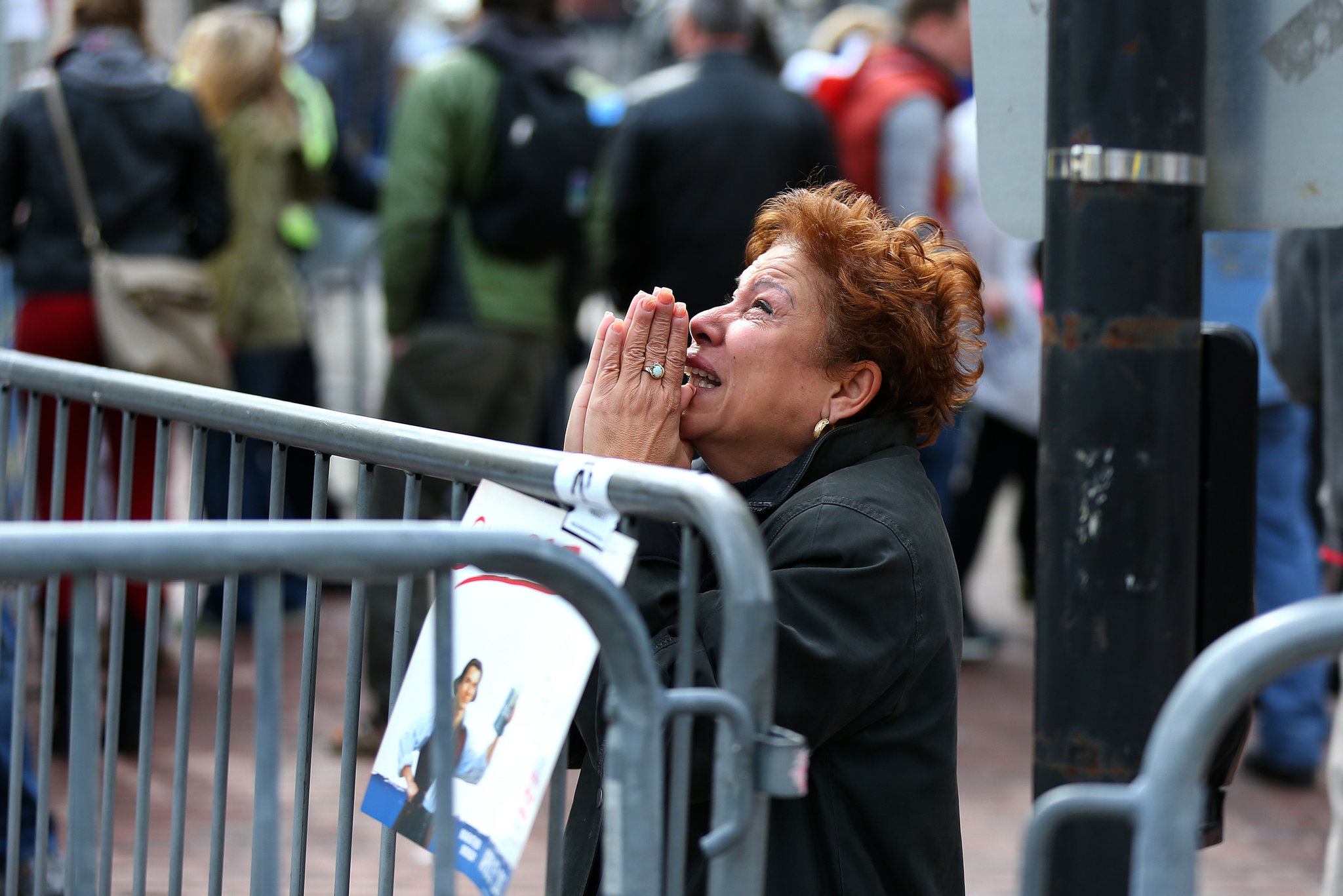
A woman prayed at the scene of the first explosion.Credit…John Tlumack/The Boston Globe
On April 15, several people who were near the scene of the blast were taken into custody and questioned about the bombing, including a Saudi man whom police stopped as he was walking away from the explosion; they detained him when some of his responses made them uncomfortable.Law enforcement searched his residence in a Boston suburb, and the man was found to have no connection to the attack.
An unnamed U.S. official said, “he was just at the wrong place at the wrong time”.
On the night of April 18, two men who were riding in a taxi in the vicinity of the shootout were arrested and released shortly thereafter when police determined that they were not involved in the Marathon attacks.Another man was arrested several blocks from the site of the shootout and was forced to strip naked by police who feared that he might have concealed explosives.
He was released that evening after a brief investigation determined that he was an innocent bystander.
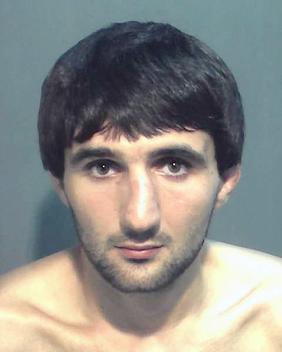
Ibragim Todashev
On May 22, the FBI interrogated Ibragim Todashev in Orlando, Florida, who was a Chechen from Boston. During the interrogation, he was shot and killed by an FBI agent who claimed that Todashev attacked him.The New York Times quoted an unnamed law enforcement official as saying that Todashev had confessed to a triple homicide, and had implicated Tsarnaev as well.Todashev’s father claimed his son was innocent and that federal investigators were biased against Chechens and made up their case against him.
Robel Phillipos (19) was a U.S. citizen of Ethiopian descent living in Cambridge who was arrested and faced with charges of knowingly making false statements to police.He graduated from high school in 2011 with Dzhokhar Tsarnaev.Dias Kadyrbayev (19) and Azamat Tazhayakov (20) were natives of Kazakhstan living in the U.S.They were Dzhokhar Tsarnaev’s roommates in an off-campus housing complex in New Bedford, Massachusetts, where Tsarnaev had sometimes stayed
Phillipos, Kadyrbayev, Tazhayakov, and Tsarnaev entered the University of Massachusetts Dartmouth in the fall of 2011 and knew each other well. After seeing photos of Tsarnaev on television, they traveled to his dorm room where Kadyrbayev and Tazhayakov retrieved a backpack and laptop belonging to Tsarnaev, while Phillipos acted as lookout. The backpack was discarded, but police recovered it and its contents in a nearby New Bedford landfill on April 26. During interviews, the men initially denied visiting the dorm room but later admitted their actions

Kadyrbayev and Tazhayakov were arrested by police at the off-campus housing complex during the night of April 18–19. An unidentified girlfriend of one of the men was also arrested,but all three were soon released.
Kadyrbayev and Tazhayakov were re-arrested in New Bedford on April 20 and held on immigration-related violations. They appeared before a federal immigration judge on May 1 and were charged with overstaying their student visas.That same day, they were charged criminally with:
willfully conspir(ing) with each other to commit an offense against the United States… by knowingly destroying, concealing, and covering up objects belonging to Dzhokhar Tsarnaev, namely, a backpack containing fireworks and a laptop computer, with the intent to impede, obstruct, and influence the criminal investigation of the Marathon bombing
Kadyrbayev and Tazhayakov were indicted by a federal grand jury on August 8, 2013, on charges of conspiracy to obstruct justice for helping Dzhokhar Tsarnaev dispose of a laptop computer, fireworks, and a backpack after the bombing. Each faced up to 25 years in prison and deportation if convicted. Tazhayakov was convicted of obstruction of justice and conspiracy on July 21, 2014.
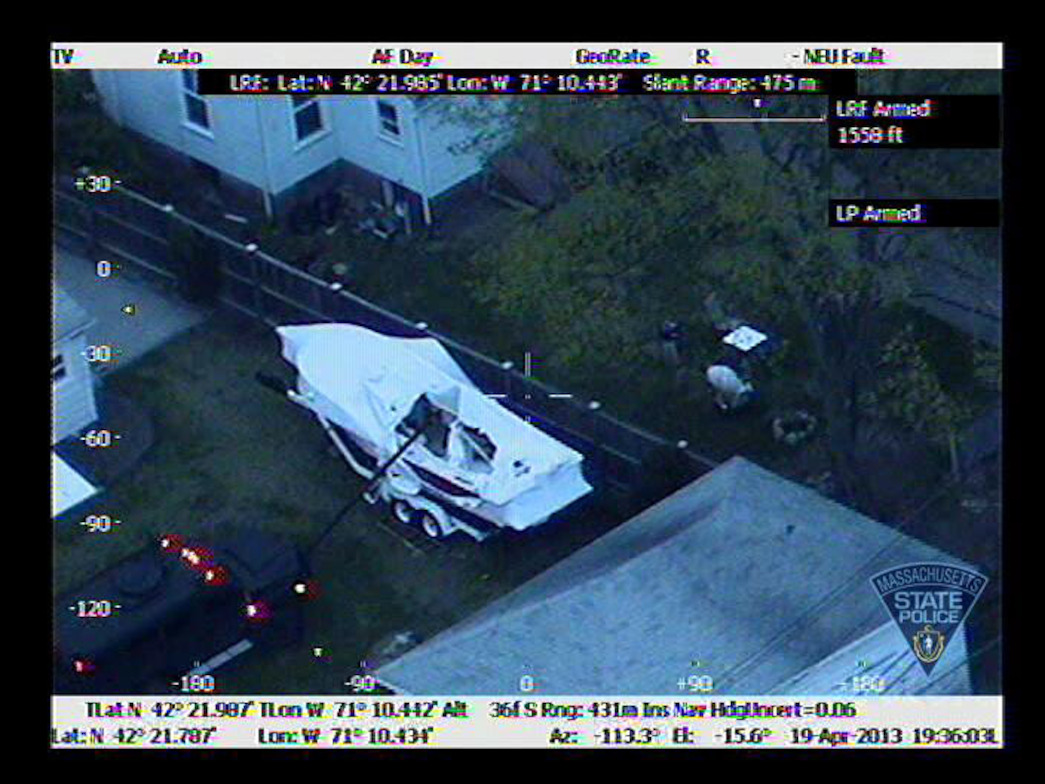
The boat in which Boston Marathon bombing suspect Dzhokhar Tsarnaev was hiding is seen from a police helicopter
Kadyrbayev pleaded guilty to obstruction charges on August 22, 2014, but sentencing was delayed pending the U.S. Supreme Court’s ruling in Yates v. United States.Kadyrbayev was sentenced to six years in prison in June 2015.He was deported to Kazakhstan in October 2018
Tazhayakov pleaded not guilty and went to trial, arguing that “Kadyrbayev was the mastermind behind destroying the evidence and that Tazhayakov only ‘attempted obstruction’.” Jurors returned a guilty verdict, however, and he was sentenced to 42 months (3+1⁄2 years) in prison in June 2015. U.S. District Judge Douglas Woodlock gave a lighter sentence to Tazhayakov than to Kadyrbayev, who was viewed as more culpable.Tazhayakov was released in May 2016 and subsequently deported
Phillipos was arrested and faced charges of knowingly making false statements to police.He was released on $100,000 bail and placed under house confinement with an ankle monitor.He was convicted on October 28, 2014, on two charges of lying about being in Tsarnaev’s dorm room. He later acknowledged that he was in the room while two friends removed a backpack containing potential evidence relating to the bombing.
Phillipos faced a maximum sentence of eight years’ imprisonment on each count.In June 2015, U.S. District Judge Douglas P. Woodlock sentenced him to three years in prison.Phillipos filed an appeal, but his sentence was upheld in court on February 28, 2017.
Phillipos was released from prison in Philadelphia on February 26, 2018, and began serving a three-year probationary period.
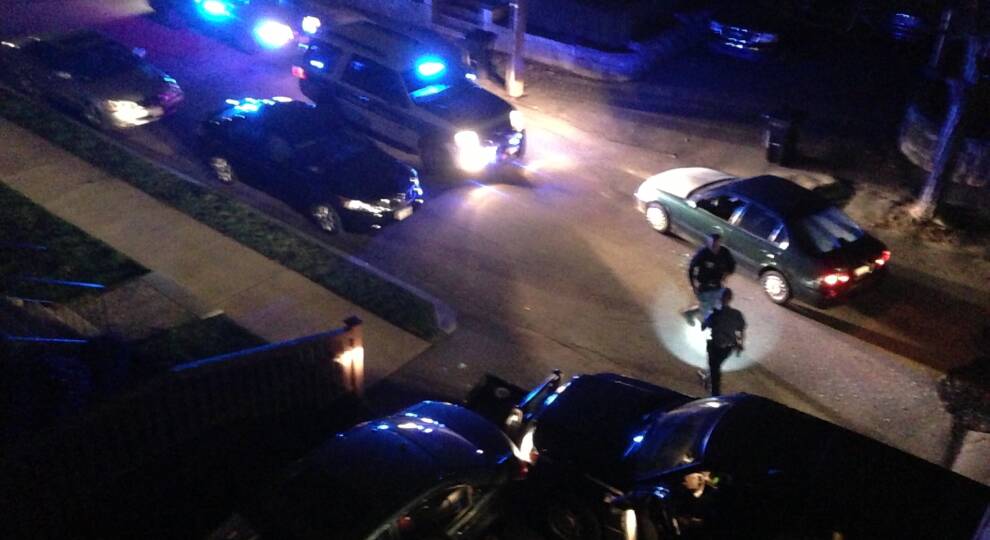
Police converge on a Watertown street during the Boston Marathon Bombing Manhunt in April.
A federal indictment was unsealed against Khairullozhon Matanov on May 30, 2014, charging him with “one count of destroying, altering, and falsifying records, documents, and tangible objects in a federal investigation, specifically information on his computer, and three counts of making materially false, fictitious, and fraudulent statements in a federal terrorism investigation”.
Matanov bought dinner for the two Tsarnaev brothers 40 minutes after the bombing. After the Tsarnaev brothers’ photos were released to the public, Matanov viewed the photos on the CNN and FBI websites before attempting to reach Dzhokhar, and then tried to give away his cell phone and delete hundreds of documents from his computer. Prosecutors said that Matanov attempted to mislead investigators about the nature of his relationship with the brothers and to conceal that he shared their philosophy of violence.
Matanov was originally from Kyrgyzstan. He came to the U.S. in 2010 on a student visa, and later claimed asylum. He attended Quincy College for two years before dropping out to become a taxicab driver. He was living in Quincy, Massachusetts, at the time of his arrest, and was a friend of Tamerlan Tsarnaev.
In March 2015, Matanov pleaded guilty to all four counts.In June 2015, he was sentenced to 30 months in prison.
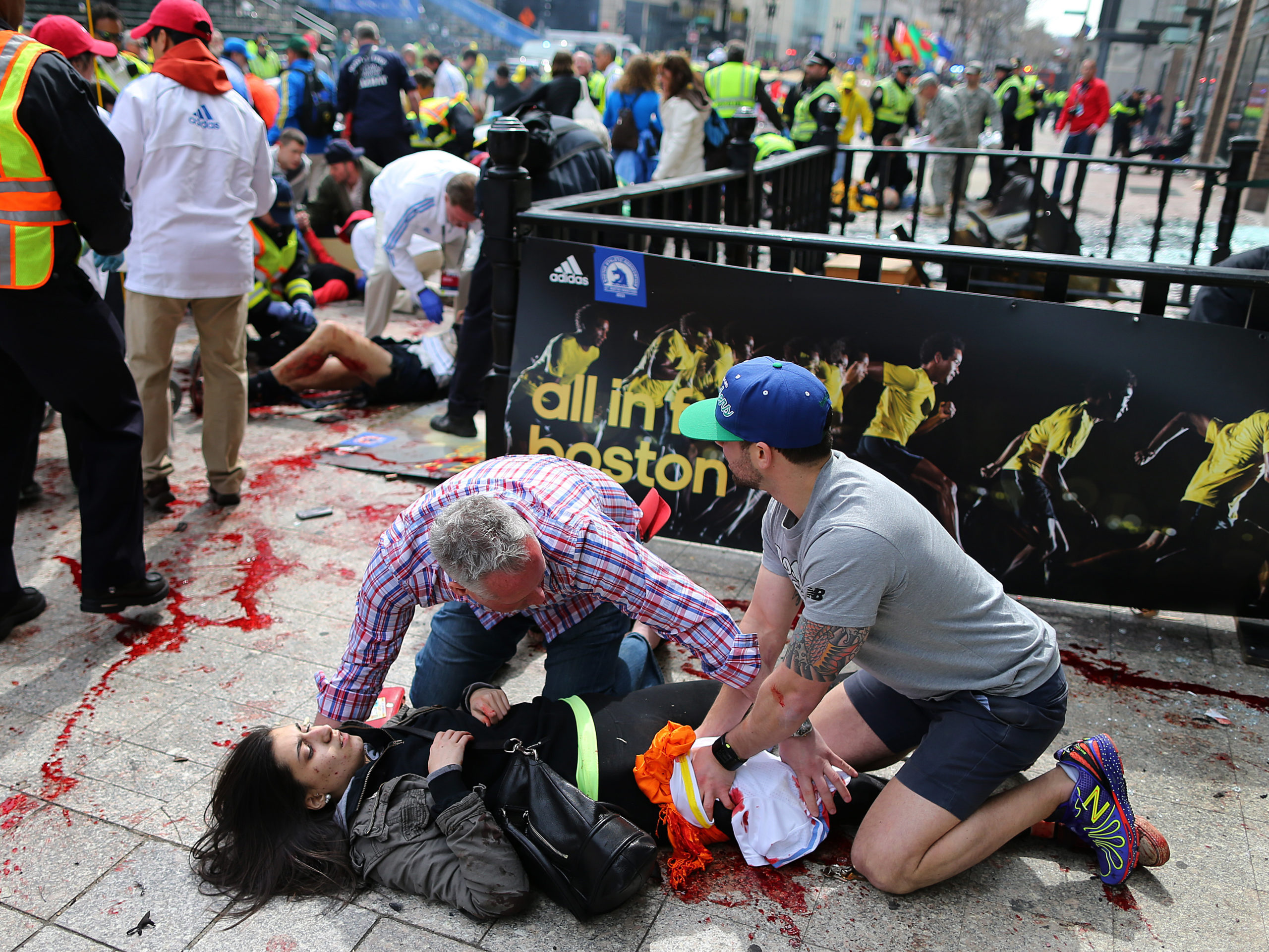
Three people were killed as a direct result of the bombings. Krystle Marie Campbell, a 29-year-old restaurant manager from Medford, Massachusetts, was killed by the first bomb.
Lü Lingzi (Chinese: 吕令子),a 23-year-old Chinese national and Boston University statistics graduate student from Shenyang, Liaoning,and 8-year-old Martin William Richard from the Dorchester neighborhood of Boston, were both killed by the second bomb.Sean Allen Collier, 27 years old, was shot and killed by the bombers as he sat in his patrol car on April 18, at about 10:48 p.m. He was an MIT police officer, and had been with the Somerville Auxiliary Police Department from 2006 to 2009.He died from multiple gunshot wounds.
Boston Police Department officer Dennis Simmonds died on April 10, 2014, from head injuries he received during the Watertown shootout a year before.
About 281 civilians were treated at 27 local hospitals.Eleven days later, 29 remained hospitalized, one in critical condition.Many victims had lower leg injuries and shrapnel wounds,which indicated that the devices were low to the ground.At least 16 civilians lost limbs, at the scene or by surgical amputation, and three lost more than one limb.
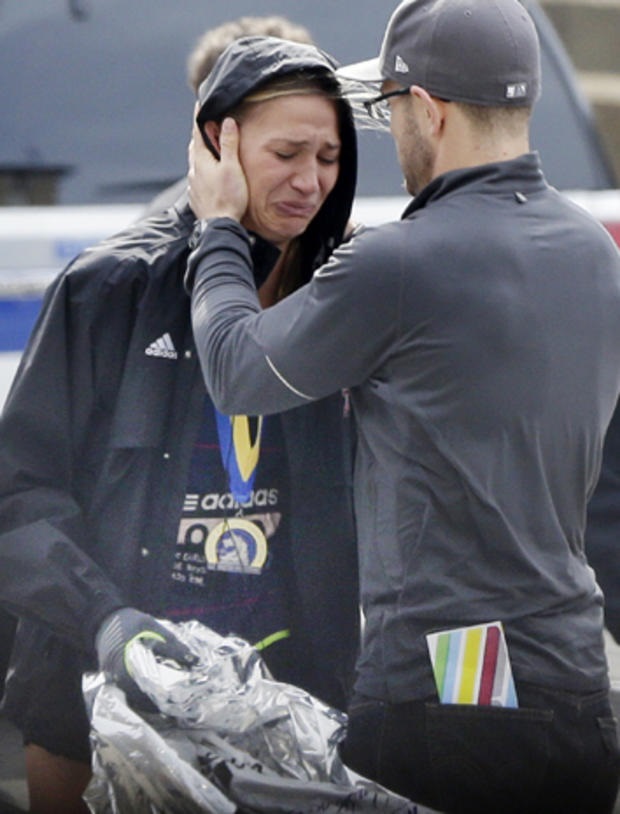
An unidentified Boston Marathon runner is comforted as she cries in the aftermath of two blasts which exploded near the finish line of the 2013 Boston Marathon
Every year, Boston celebrates Patriots’ Day on the third Monday of April with the Boston Marathon, the oldest annual marathon in the world. It is one of the most beloved running events not just for Bostonians, but for athletes around the globe.
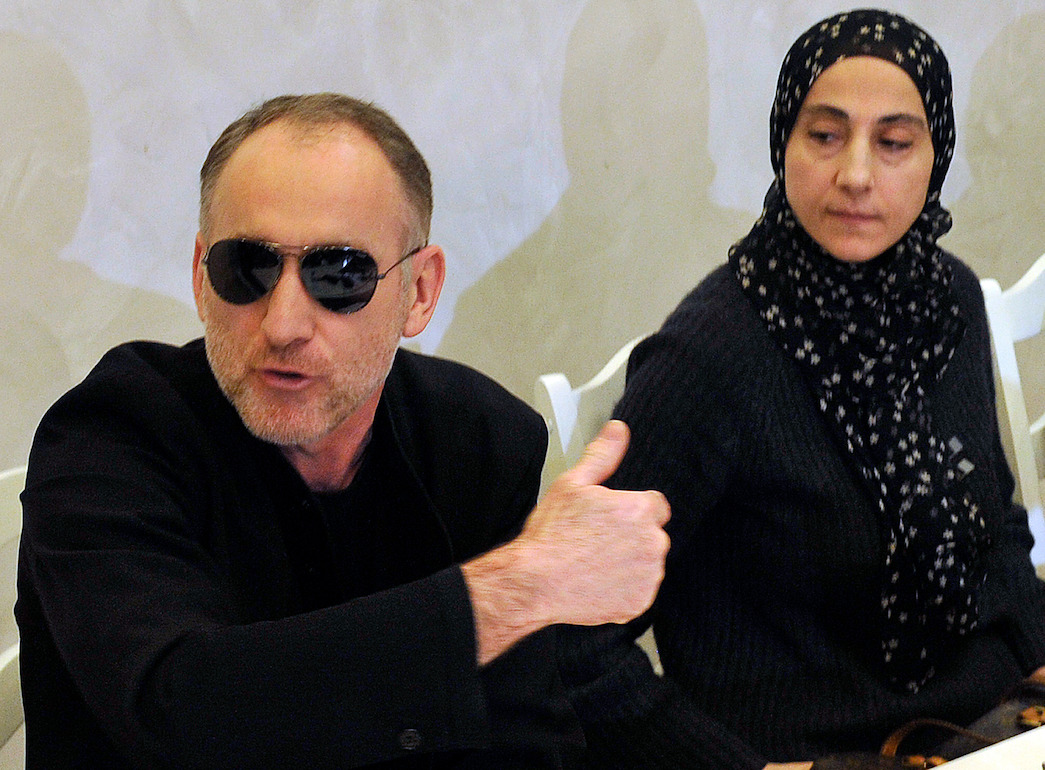
Anzor Tsarnaev and Zubeidat Tsarnaeva.2002-2003
Anzor Tsarnaev moves his wife and four children, including Tamerlan and Dzhokhar, from Russia to the Boston area. The family was able to receive asylum because Anzor was an ethnic Chechen fleeing oppression. In the series,
Filipov says Anzor “was seeking the American dream.” But, he adds, “Then they get here, and this dream, it wasn’t real.”
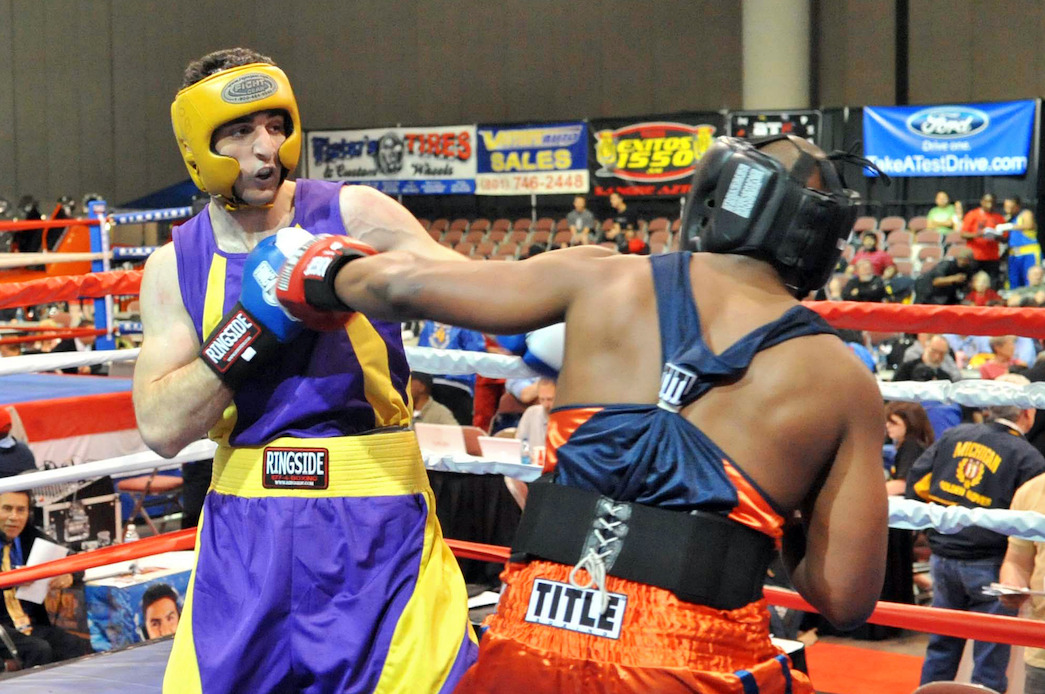
Tamerlan Tsarnaev in a boxing match in 2008 -2009.
Boxing trainer John Allan begins working with a talented Tamerlan Tsarnaev in his early 20s. Allan says Tamerlan was good enough to have made it to the Olympics, but couldn’t compete in qualifying events because he was not a citizen. Tamerlan claimed that he believed he was barred because of his Muslim identity and that officials didn’t want him representing the US.
September 11, 2011: Two years before the Boston bombing:
Tamerlan’s best friend, 25-year-old mixed martial arts fighter Brendan Mess is a victim in a triple murder in Waltham, Massachusetts. In the docuseries,
Allan recalls Tamerlan being unsympathetic, saying, “That’s the type of stuff that happens to you” (if you do bad things).
In 2013, a few weeks after the bombing, police and the FBI interview Tamerlan’s friend Ibragim Todashev, who allegedly confesses to killing three men, including Mess. During the confession, agents say Ibragim tried to attack them, and he is shot and killed by the FBI.
Summer 2012:
Tamerlan travels to Dagestan, which investigators believe may have played a role in Tamerlan’s radicalization. In the docuseries,
Boston Globe reporter Filipov says, “(The bombing) probably wasn’t something he decided (to do) when he went to Dagestan. I think he went to Dagestan trying to find meaning.”

A view of the finish line during the 2013 Marathon
Hour 00 Monday, April 15, 2013, 2:49 PM:
Five hours into the race, two pressure cooker bombs go off near the finish line.
Hour 02, Monday, April 15, 2013:
Law enforcement seals off the crime scene. Bomb techs sweep the area for more explosives, which they do not find.
Hour 03, Monday, April 15, 2013:
State troopers track down anyone at the airport who may have photos of the finish line on their cameras. Police send investigators out to question people injured in the bombing. They receive a report of a “suspicious person” who was taken to the emergency room, an injured Saudi man. He is questioned by the police. In the series, senior investigative reporter for GBH News Phillip Martin says that the man became an early suspect, which colors the rest of the investigation as a crime potentially “related to Al Qaeda.”
Hour 05, Monday, April 15, 2013:
Police send a SWAT team and detectives to the suspect’s home where they find “suspicious things” like official documents and passports. The police ultimately determine that their suspect was actually a victim, who was injured in the bombing. “He happened to be a Saudi near the finish line who was living in an age of Islamophobia,” Martin says. The city holds a press conference seeking information from the public.
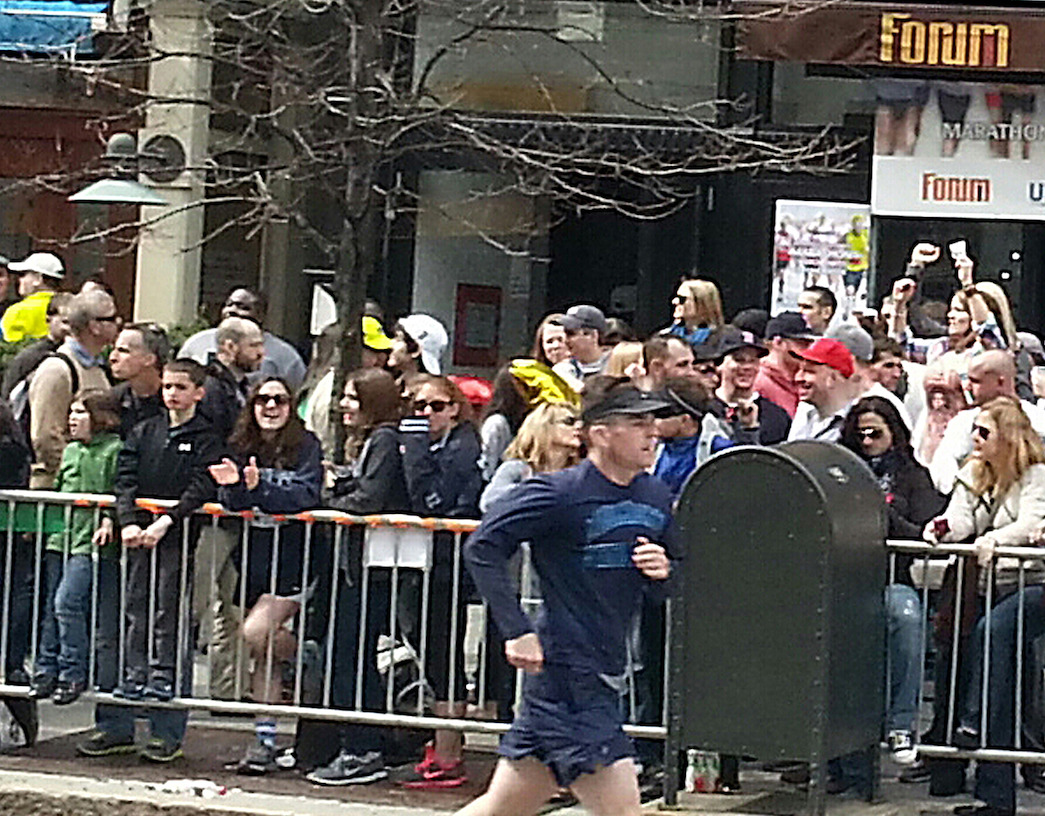
A cell phone image of Dzhokhar Tsarnaev in the white hat.
Hour 11, Tuesday, April 16, 2013:
The Boston FBI’s Cyber Division begins collecting hundreds of thousands of videos from civilians and businesses on the route to and from the finish line.
Hour 17, Tuesday April 16, 2013:
Evidence response teams find two backpacks at the crime scene that they believe carried the bombs. Bomb experts say the devices were remote-controlled.
Hour 21, Tuesday April 16, 2013:
President Obama calls the bombing an act of terrorism.
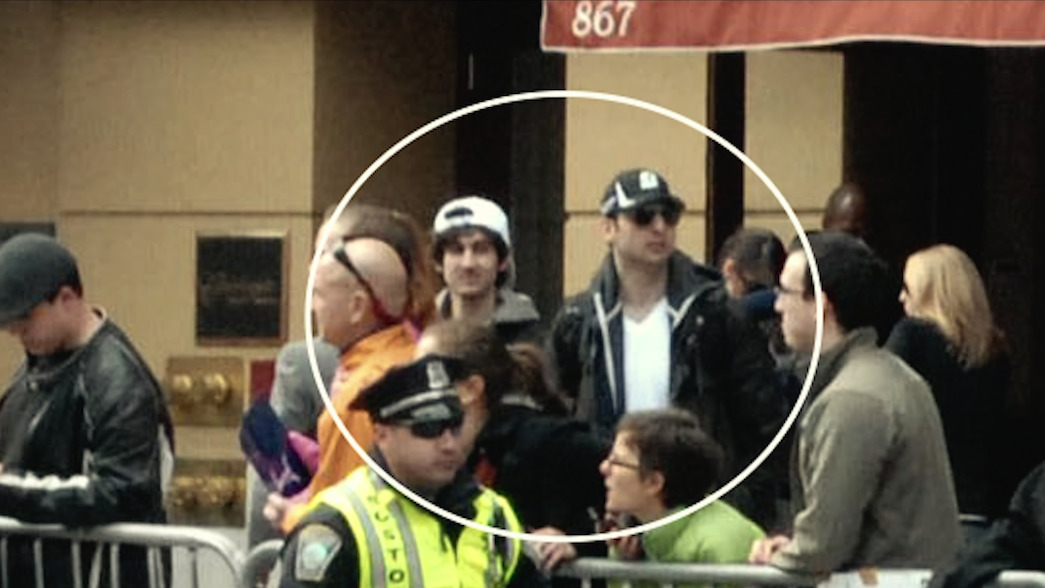
Dzhokhar Tsarnaev and Tamerlan Tsarnaev.
Hour 23, Tuesday April 16, 2013:
The Cyber Division receives video evidence from a restaurant near where the second explosion went off, which shows a young man dropping a backpack on the ground and walking away as the first bomb detonates. They also receive a call from a civilian who was across the street from the explosion, and has photos of the same young man with the bag on the ground. They call him “White Hat.”
Hour 53, Wednesday, April 17, 2013:
Law enforcement continues collecting video evidence from businesses along Boylston Street, when they find surveillance footage from a bar that identifies “White Hat” walking around the corner with another man carrying a backpack who they identify as “Black Hat.” They now have pictures of two suspects.
Hour 65, Thursday, April 18, 2013:
President Obama attends a memorial service in Boston. Images of the suspects are leaked to a Boston news outlet. Authorities had feared that making such images public would cause the suspects to panic and engage in reckless and violent behavior. Learning of the leak, the FBI decides to release the pictures of the suspects.
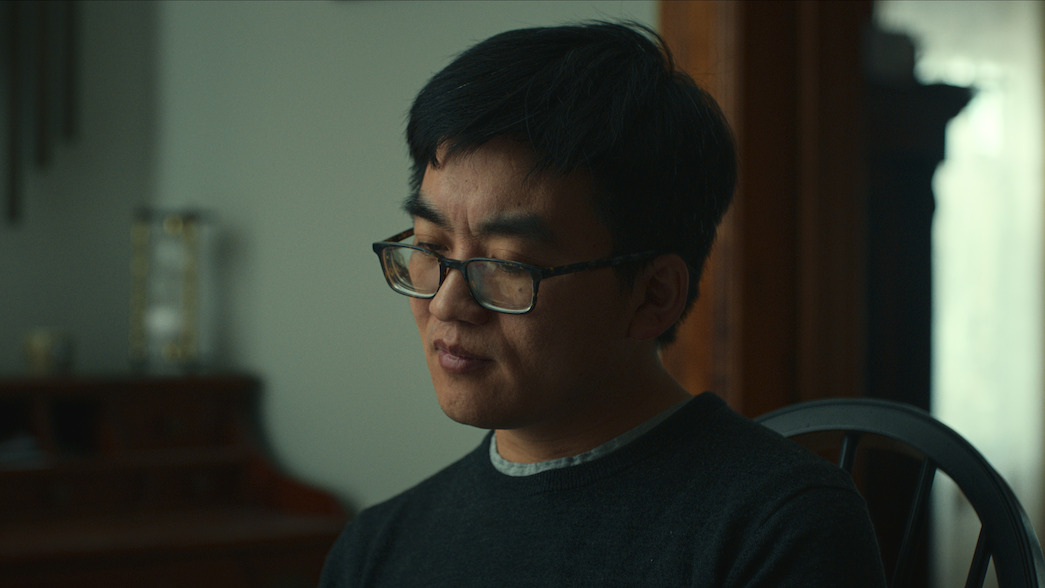
Danny Meng
Hour 80, Thursday, April 18, 2013:
Police are called to the Massachusetts Institute of Technology (MIT) in Cambridge. MIT police officer Sean Collier has been shot and killed. Soon afterward, 26-year-old tech entrepreneur Danny Meng pulls over to respond to a text while driving. A car pulls over behind him, and one of the passengers gets out of the car and holds Danny at gunpoint. After driving for a while, with Dzhokhar tailing the Mercedes in another car, Tamerlan forces Danny into the passenger seat and takes the wheel, and Dzhokhar gets into the Mercedes. Tamerlan tells Danny that he carried out the Boston Marathon bombing and killed a police officer in Cambridge and begins to drive to NYC.
Hour 81, Friday April 19:
Danny convinces the men to stop at a gas station in Cambridge to fill up before making the long drive to NYC. Seeing an opportunity, Danny manages to escape from his car, and runs across the street to another gas station where he asks a clerk to call the police. Using the transmitter number for Danny’s GPS system, police track down the Mercedes to Watertown. Cambridge police alert Watertown police, who begin tailing the car.
A firefight begins in the middle of a residential street between the brothers and Watertown police, who do not know yet that they were the Boston bombers. All Watertown units are called to the Dexter Avenue area. Sergeant John MacLellan maneuvers his vehicle toward the Mercedes, and the brothers throw pipe bombs and a pressure cooker bomb at law enforcement.
Boston police and Cambridge police send units to Watertown. In the series, MacLellan recalls that the firefight had a high potential of civilian casualties: “At least one of the residents came out three times.” After being shot, Tamerlan charges toward MacLellan, where police begin to restrain him. Dzhokhar gets into the Mercedes and speeds toward police, running over Tamerlan before fleeing. While no residents are injured in the shoot-out, their homes are riddled with bullet holes. Police quickly locate the abandoned Mercedes, but Dzhokhar is nowhere to be found.
Hour 82, Friday April 19:
Watertown police learn the suspects are the Boston Marathon bombers. Tamerlan is taken to the hospital and pronounced dead. Police identify him, and the FBI learns it has a file on him.
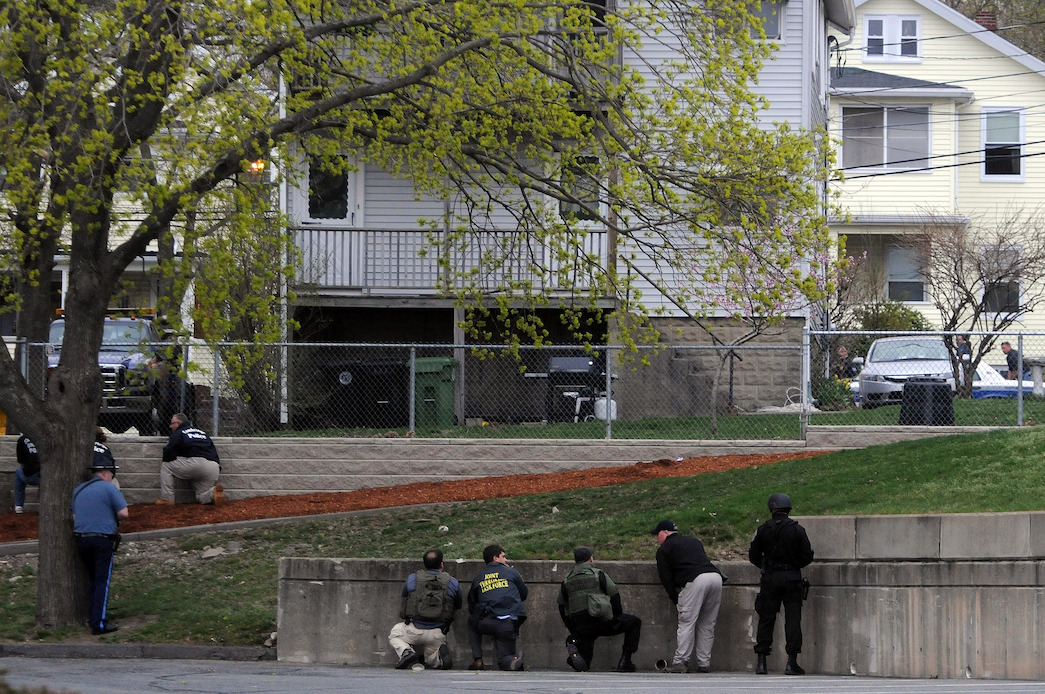
Law enforcement approach an area where a suspect is hiding in Watertown, Massachusetts.
Hour 83, Friday April 19:
Police identify the missing suspect as Tamerlan’s brother, Dzhokhar Tsarnaev. Law enforcement begins searching Watertown house by house.
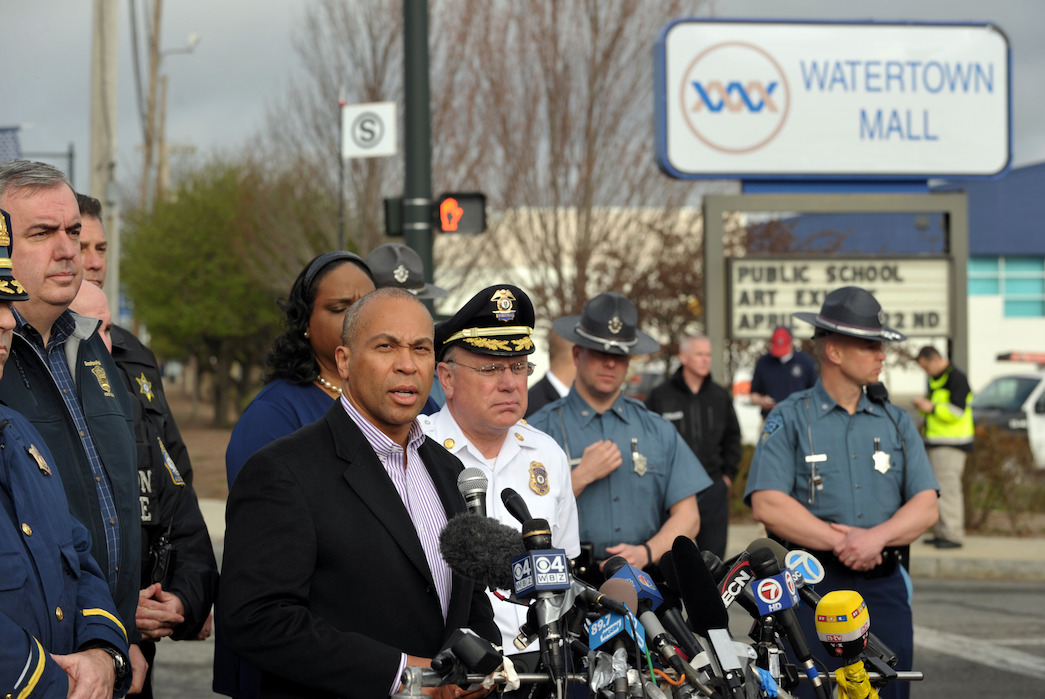
Massachusetts Governor Deval Patrick with Boston Police Commissioner Ed Davis.
Hour 84, Friday, April 19:
Governor Deval Patrick holds a press conference. Public transit is suspended, and some one million residents across eastern Massachusetts are asked to shelter in place.
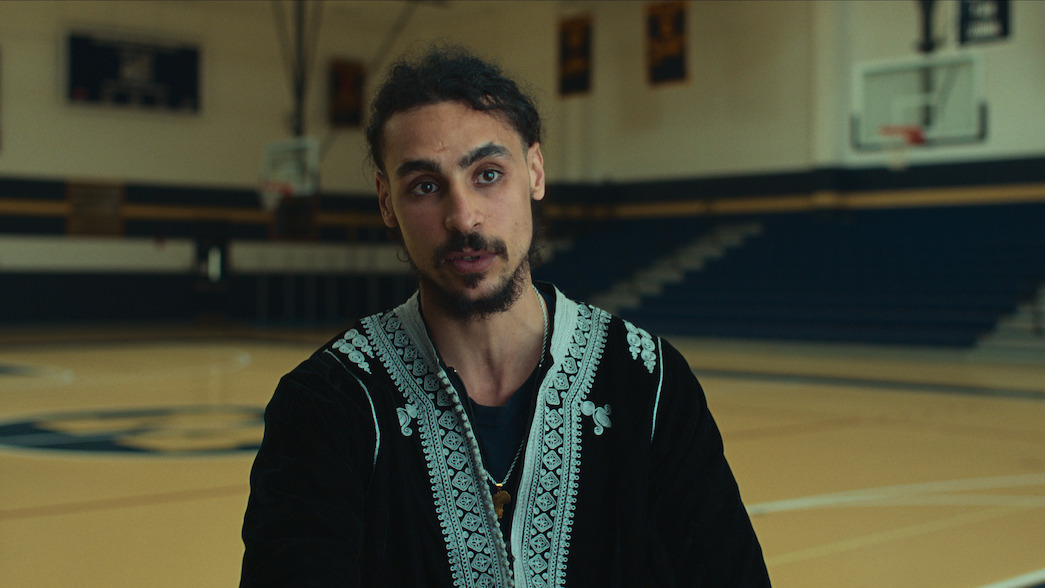
Dzhokhar’s schoolmate, Youssef Eddafali
Hour 88, Friday April 19:
Police search the Tsarnaev residence in Cambridge. They find bomb-making paraphernalia, but Dzhokhar is not there. Police question Tamerlan’s wife Katherine Russell. Police release Tamerlan and Dzhokhar’s names to the public.
“When I found out that it was Dzhokhar, I couldn’t wrap my head around it,” says schoolmate Youssef Eddafali in the series. “I had cognitive dissonance.”
A view of the quad at the University of Massachusetts Dartmouth campus.
Hour 95, Friday April 19:
Massachusetts State Police dispatches a tactical team to Dzhokhar’s apartment at UMass Dartmouth. Students are evacuated from campus.
Hour 98, Friday April 19:
President Obama contests the governor’s shelter in place order, which is lifted at 6:03 p.m. Public transit goes back in service, and law enforcement sends their teams home for the night.
 The boat in which Boston Marathon bombing suspect Dzhokhar Tsarnaev was hiding is seen from a police helicopter.
The boat in which Boston Marathon bombing suspect Dzhokhar Tsarnaev was hiding is seen from a police helicopter.
Hour 99, Friday April 19:
Police receive a call at 6:42 p.m. from a Watertown resident who says a person is hiding in the boat in their backyard, the location of which is only one block away from where Dzhokhar abandoned Danny’s stolen Mercedes. Multiple units respond to the call, including police officers who, according to reporter Phillip Martin in the docuseries, are not authorized to be there. Without warning, police begin shooting.
“It was initially reported as a shoot-out. Of course, now we know it was a shoot-in,” says Martin in the series, adding that 126 rounds hit the boat. Some more bullets missed the boat, and were fired into the neighborhood. In American Manhunt, the FBI claims police began shooting because they saw a gun.
Hour 100, Friday April 19:
A state police helicopter pilot says there is movement in the boat. The FBI hostage recovery director receives permission to throw a smoke grenade and flash-bang into the boat, even though the flash-bang could blow up the house. After a period of time, Dzhokhar gives himself up, and he is unarmed. Says Boston Police Commissioner Ed Davis in the docuseries, there was a lack of “command and control” during both shoot-outs that prevented a coordinated police response.
Boston Police Superintendent Billy Evans says, “What happened was one officer fired, everyone starts to fire.”
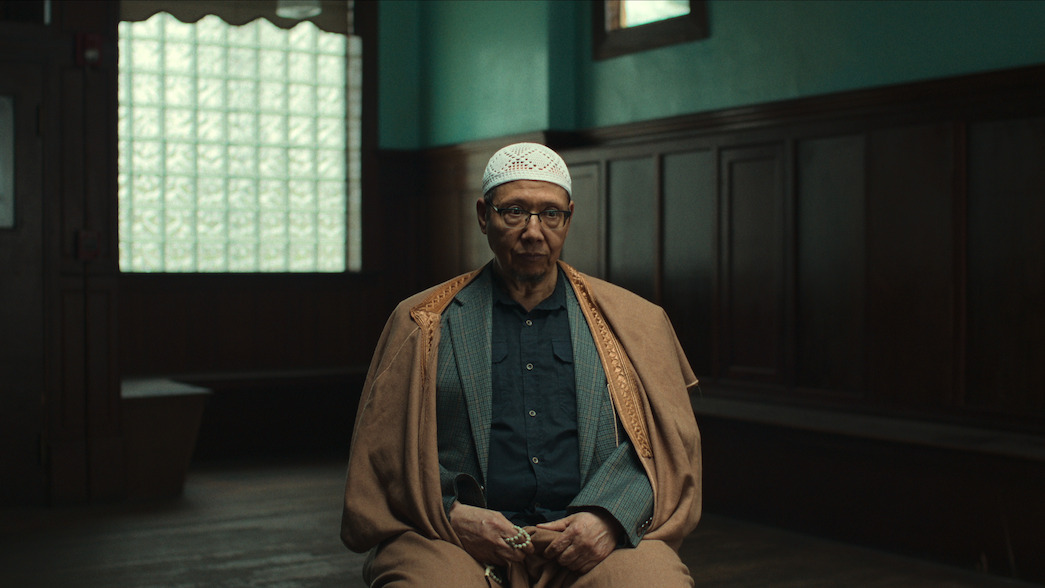
Ismail Fenni of the Islamic Society of Boston
Saturday, April 20:
Law enforcement question Dzhokhar in the hospital, and he asks for a lawyer. Police say they found a “jihadi manifesto” written inside the boat. “Whenever I hear somebody speak about jihad in the connotation of killing, I cringe,” Ismail Fenni of the Islamic Society of Boston says in the series. “Jihad means to struggle.
We struggle to get a good life. That’s jihad. You struggle to be an honest person. That’s jihad. You struggle to be a good religious person. That’s jihad. Jihad is not picking up a gun, or making a bomb and killing innocent people.”
After several days of questioning, Dzhokhar is finally read his Miranda rights.
The FBI investigates his friends. “The FBI came down on everybody, but I know they specifically targeted my Muslim peers way more than any other demographic,” Eddafali says in the docuseries. Right-wing media push the narrative of a “radical Islam attack” on Boston and use their platforms to call for racial profiling of Muslims. Police say Dzhokhar’s friends tried to dispose of evidence against him in a garbage dump after they recognized him on the news. They are charged with obstruction of justice.
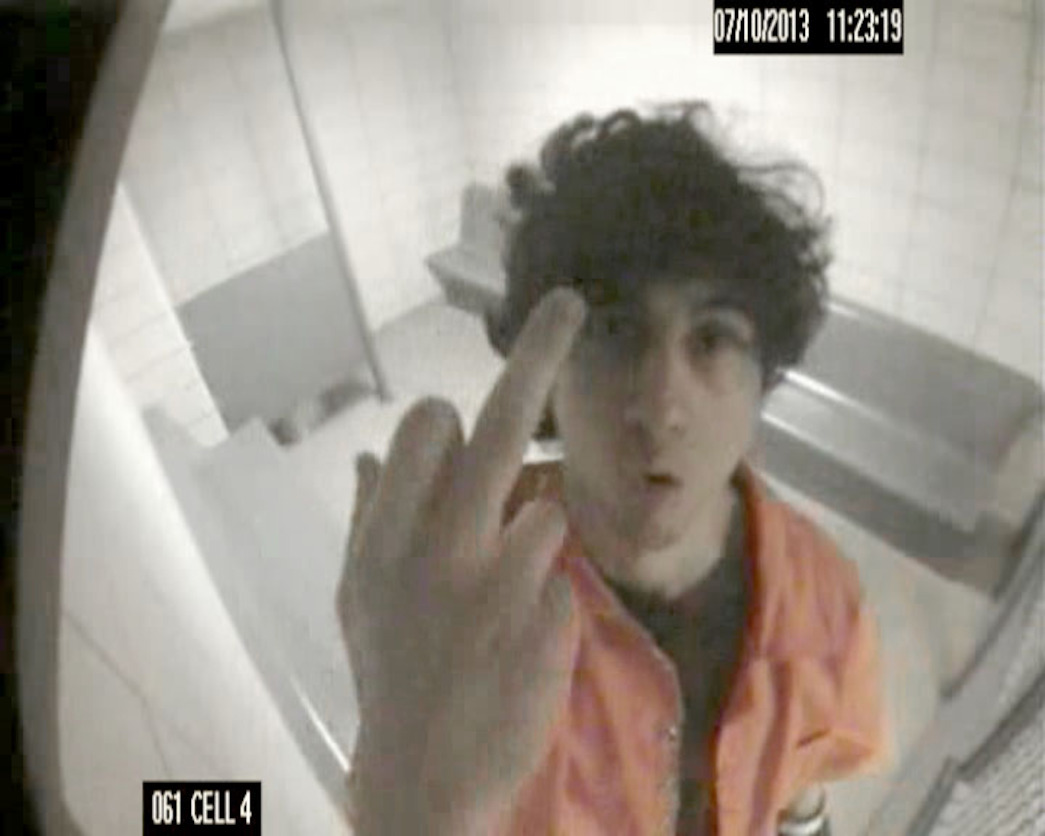
Dzhokhar Tsarnaev is seen giving the middle finger to a security camera inside his jail cell.
March 4, 2015:
Dzhokhar’s trial begins. US Attorney Carmen Ortiz’s office releases an image supposedly showing Dzhokhar giving the finger to a camera in his prison cell. In the series, Ortiz also mentions video footage of Dzhokhar calmly shopping after the bombing as an indication of his lack of remorse. The judge does not allow the Waltham killings into evidence, preventing the defense from making a case that Tamerlan, suspected in the gruesome murder of his own best friend, was capable of ruthlessness and that Dzhokhar was under his influence, says reporter Phillip Martin.
After being overturned by appeal, Dzhokhar’s death penalty was reinstated by the Supreme Court in 2022. He is appealing again.
